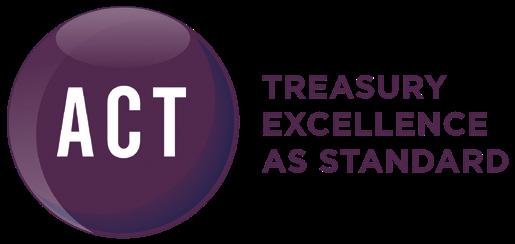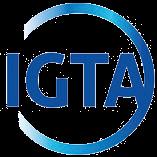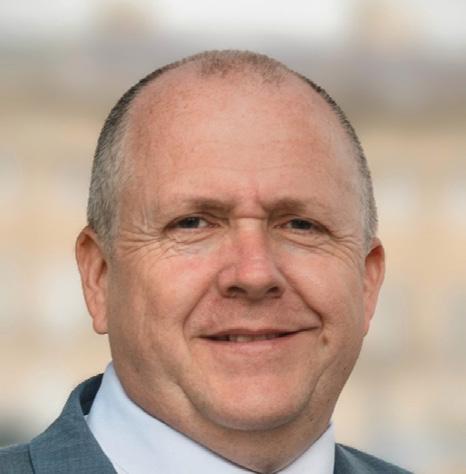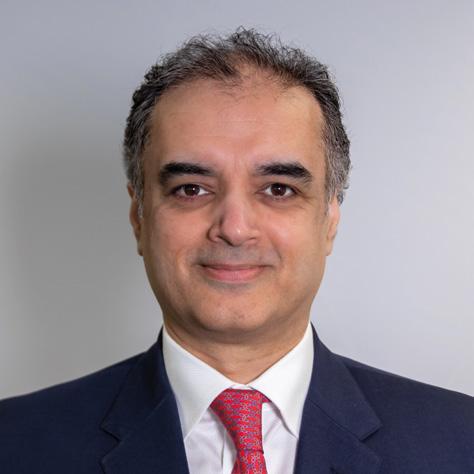TEAM BUILDING
19
LONDON’S LORD MAYOR
24
Why the City is the world’s coffee house
SUPERMARKET SWEEP
How treasurers help create a resilient mindset WEATHERING
What happened when Morrisons went private

32
THE MAGAZINE OF THE ASSOCIATION OF CORPORATE TREASURERS ISSUE 1 2024

geopolitical clouds could mean a bumpy ride in 2024
THE STORM Why

For professional clients only, not suitable for retail clients. This is a financial promotion and is not investment advice. Telephone calls may be recorded. For further information please see our Privacy policy at www.rlam.com Issued in November 2023 by Royal London Asset Management Limited, 80 Fenchurch Street, London, EC3M 4BY. Authorised and regulated by the Financial Conduct Authority, firm reference number 141665. A subsidiary of The Royal London Mutual Insurance Society Limited. Ref: ADV RLAM PD 0011 Owned by clients, managed for clients. We’re a different kind of asset manager. Royal London Asset Management is part of the UK’s largest mutually owned pension and investment company. We help clients - from the largest institutions to pension scheme members - achieve their investment goals, with a commitment to managing our clients’ assets in the right way. Visit www.rlam.com to find out more.

The Treasurer is the official magazine of The Association of Corporate Treasurers
150 Minories, London EC3N 1LS United Kingdom +44 (0)20 7847 2540 treasurers.org
Policy and technical Naresh Aggarwal, Sarah Boyce, James Winterton Commercial director Denis Murphy Director of marketing and communications Anne Hogarth Technical review Ian Chisholm, Steve Ellis, Anu Mensah, Joe Peka, Alison Stevens, Neil Wadey, Peter Walker-Smith
ADVERTISE WITH US
For advertising and sponsorship opportunities, contact deputy commercial director Simon Tempest +44 (0)20 7847 2580 stempest@treasurers.org
THE TREASURER ©2024
Published on behalf of the ACT by CPL One 1 Cambridge Technopark, Newmarket Road, Cambridge CB5 8PB +44 (0)1223 378000 cplone.co.uk
Editor Philip Smith phil.smith@cplone.co.uk
Managing editor Helen King
Publishing editor Sophie Hewitt-Jones Art director Chloe Bage
SUBSCRIPTIONS
Europe, incl. UK (per annum)
1 year £285 | 2 years £405 | 3 years £525
Rest of world
1 year £320 | 2 years £495 | 3 years £655
Members, students and IGTA/ EACT members
[Self-certifiedmembersofNationalTreasury Associations,includingtheAFPintheUS]
1 year £142 – UK and Europe (MUKEU)
1 year £185 – rest of world (MRoW)
For information, visit treasurers.org/ thetreasurer/subscription

STORM WATCHING
It can’t have escaped anyone’s notice that 2024 is the year of elections – from the US presidential and congressional votes, through to India, the EU and possibly/probably the UK general elections, it seems like the whole world will be casting its vote at some point. In fact, according to Time magazine, 64 countries plus the EU, representing nearly half of the global population, will be going to the polls.

All this political activity inevitably leads to uncertainty and instability, which, of course, creates financial risk. Alongside the ongoing conflicts in Ukraine and Gaza, plus looming supply chain threats as the Red Sea shipping route closes down (hopefully only temporarily), you can see that treasurers face a perfect storm of geopolitical uncertainty.
financial markets, to devastating effect. For instance, treasurers are being warned to be on their guard for suspicious payment requests that come from an apparently trusted source. In fact, many believe that 2024 will not only be the year of the election, but could also prove to be the year of the deepfake.
“All this political activity inevitably leads to uncertainty and instability”
We also explore how treasurers can build teams that are resilient and capable of thriving during these uncertain times, while a former editor of the magazine, Sally Percy, tells us what she learned from analysing how good leaders build great teams. In addition, we hear from Mark Hirst, the group treasurer of iconic footwear brand Dr. Martens, about his own experience of building a treasury team.
As one commentator in our main feature says: “It is likely that the geopolitical risk will continue to be the main driver impacting the global economy, financial markets and commodity prices.” The message is clear – treasurers need to expect the unexpected (again).
But help is at hand, thanks to our friend artificial intelligence (AI). After the launch of generative AI solution ChatGPT late in 2022, the coming 12 months will see many treasurers getting to grips with AI as a tool in their risk management, providing data, forecasting, and helping prepare for Black Swan events.
The downside, of course, is that this same technology could be used increasingly by ‘bad actors’, either in the political arena or the
Finally, I was particularly delighted that the Lord Mayor of London, Michael Mainelli, took time out from his hectic schedule to tell us why he believes the City of London remains the pre-eminent financial centre for fundraising. He points to the many diverse skills that can be found within one square mile of the capital and how important it is to remember that the City is still the coffee shop of the world.
Such insights will, I’m sure, help treasurers weather the oncoming storms.

phil.smith@cplone.co.uk
Follow us on X @thetreasurermag


PAGE 10
PAGE 22

Michael Mainelli
695th Lord Mayor of London, on how he
PAGE 24
treasurers.org/thetreasurer ISSUE 1 2024 3
THIS ISSUE’S CONTRIBUTORS The copyright of all editorial in this magazine is reserved to the publishers. None of the articles published may be copied, duplicated or reproduced in any form without the prior consent of The Association of Corporate Treasurers. The Association of Corporate Treasurers, the publisher and editor cannot accept responsibility for any claim which may be made against a contributor arising out of the publication of any article or letter. The views and opinions expressed in this magazine are not necessarily those of the Council of The Association of Corporate Treasurers.
Gavin Hinks unpicks the geopolitical uncertainties of 2024 and their potential impacts
Sally Percy describes how an analysis of business leaders reveals how they built great teams
believes the City remains the coffee house of the world
This magazine is printed by the Manson Group in St Albans, UK on paper certified to be from sustainable European sources. The Manson Group operates a system to manage and reduce their environmental impact. Find out more: tmgp.uk/enviro and www.mansongroup.co.uk/ environment ISSN: 0264-0937
Photography and illustration: iStockphoto.com Cover: Adobe Firefly, Adobe Stock, Chloe Bage


bottomline.com See Payments & Cash More Clearly Join thousands of UK businesses who rely on Bottomline solutions Better Payments, Bigger Results
Battles at the ballot box, supply chain shocks and the fight against inflation look set to test treasury resilience
15
The EU continues to make progress with its Capital Markets Union project, but tangible results are hard to spot
19
Leading specialists offer advice on developing a resilient mindset for effective treasury teams 22
Sally Percy looks at lessons we can learn from successful leaders 24
why the City continues to be the place for corporates to raise cash



Experts
What issues are top of the agenda for

Deloitte’s
Malcolm
Tokenised


treasurers.org/thetreasurer ISSUE 1 2024 5 Contents 48 What do you think of this issue of The Treasurer? Please write to phil.smith@cplone.co.uk or tweet @thetreasurermag 50 34 BEST PRACTICE40 NEW CHALLENGES Key takeaways from two ACT events: the Treasury Forum and the ESG Conference 42 JOBS MARKET Eliot Bates, of Brewer Morris, explains recruitment remains buoyant 43 INFOGRAPHIC Red Sea conflict adds to inflation concerns 45 CALENDAR ACT events and course dates 46 CHARITY IN ACTION Learn about the ACT’s charitable initiatives 48 A DAY IN THE LIFE Dr. Martens group treasurer Mark Hirst 50 END NOTES ACT chief executive Annette Spencer LONG VIEW -
NAVIGATING THE STORM
10
UNION BLUES
TEAM BUILDING
LEADERSHIP
THE WORLD’S COFFEE HOUSE
on
FUTURE TRENDS26 FX VOLATILITY
Lord Mayor of London Michael Mainelli
share
personal experiences of foreign exchange fluctuations
CASH MANAGEMENT
their
30
cash
SUPERMARKET CHECKOUT
treasurers adapting approaches to manage
and working capital? 32
private equity
treasury function
VIEW FROM…
Luke Harrison, interim head of treasury at Morrisons, describes how
can transform the
34
Cooper spells out the questions treasurers should
to be asked
their non-executive directors
TECH FOCUS
expect
by
36
deposits: what are they and why do they matter? 36 10
TOMORROW’S TREASURER
THRIVING IN UNCERTAINTY
• Meet over 1,000 treasury and finance professionals for two full days of networking.
• Explore the latest treasury topics and hear exclusive insights from senior leaders shaping the business landscape.
• Discover the latest innovations in the largest treasury exhibition in the UK.
• Join fellow delegates at the networking dinner at Liverpool Cathedral.

BOOK NOW AT: TREASURERS.ORG/ACTAC24 | #ACTAC24

UNLOCK YOUR TEAM’S POTENTIAL

Transform your team’s potential in finance and treasury with our globally recognised qualifications.
Empower your team with the skills and knowledge required to master treasury, cash and liquidity management and boost their performance.
Our professional qualifications are delivered online and allow your team to develop the strong competencies needed to excel at work. They will gain a qualification that demonstrates the highest standards of professionalism.
Invest in their professional development, invest in your team’s success.
Tactical Level Certificate in Treasury Fundamentals 3 - 6 Months
Operational Level Certificate in Treasury
9 - 12 Months
Tactical Level Award in International Cash Management 1 - 3 Months
Operational Level Certificate in International Cash Management 3 - 6 Months
Managerial Level Diploma in Treasury Management
12 - 18 Months
Learn more at: learning.treasurers.org/qualifications GOT QUESTIONS? ASK OUR TEAM at learning@treasurers.org or on +44 (0) 20 7847 2529
QUALIFICATIONS TO SUIT ANY CAREER STAGE
10
NAVIGATING THE STORM
Battles at the ballot box, the fight against inflation and supply chain shocks will test treasury resilience
LONG VIEW
Analysis of long-term trends
15
UNION BLUES
The EU’s progress towards a capital markets union continues, but tangible results are hard to spot
IN IT TOGETHER
Management author Sally Percy looks at what team building lessons can be learnt from senior business leaders
treasurers.org/thetreasurer ISSUE 1 2024 9
22

LONG VIEW 10 ISSUE 1 2024 treasurers.org/thetreasurer
NAVIGATING THE STORM

As the geopolitical landscape unfolds in 2024, battles at the ballot box, the ongoing fight against inflation and supply chain shocks will test treasury resilience

Treasurers could be forgiven for resisting the urge to look ahead at the coming year. Wars rage in Ukraine and Gaza, the global economy is uninspiring and major elections loom that cast a shadow over prospects for political stability in some of the world’s most important economies.
Conditions around the world are nothing if not dispiriting. Yet observers believe there are tantalising signs of improvement, indications that treasurers should be preparing not just for downside risks, but also for an upside driven by easing economic conditions.
“It is likely that the geopolitical risk will continue to be the main driver impacting the global economy, financial markets and commodity prices,” says Stewart Hagell, a director of corporate treasury services at KPMG.
“As long as Russia-Ukraine continues, the EU economy will continue to be impacted and the prices of key commodities will be at risk of renewed volatility, while further escalation of the Israel-Gaza conflict may lead to increased oil and gas prices.”
The world knows well the impact of major shocks on commodity prices. When Russia invaded Ukraine in February 2022, energy prices soared, followed by wheat prices, as the war threatened shipping in the Black Sea.
Since then, the world has been coping with the impact on inflation and higher interest rates as central banks attempt to bring economies under control.
However, the wars in Ukraine and Gaza show no signs of abating and there are other geopolitical events on the horizon that could be cause for concern. Americans will go to the polls in November, for US presidential elections where Donald Trump is considered to have a high chance of returning to power.
A general election is expected in the UK, too, with polls currently suggesting a change in regime. Elections elsewhere mean the world’s political topology could be set for upheaval.
According to Lisa Dukes, co-founder of the treasury risk consultancy Dukes & King and member of the Bank of England foreign exchange standing committee, the lesson for treasurers from Russia’s invasion of Ukraine is precisely that it was not anticipated.
“The geopolitical landscape over the past two to three years has substantially changed and none of those events were foreseen.” The ‘new normal’ for treasurers, she adds, is managing with an “elevated risk profile”.
Acknowledging the lack of preparation ahead of the impact of the Russia-Ukraine war on
treasurers.org/thetreasurer ISSUE 1 2024 11 LONG VIEW
“Treasury policies were not agile enough to react to change quickly”
commodities is a key issue for other treasury experts. Karlien Porre, a partner in global treasury advisory with Deloitte, says treasury teams need to be prepared across three elements: their mindset, agility and financial resilience.
Mindsets should be outward looking, not just inward. Resilience is about having ‘headroom’ in financial facilities and liquidity. But she stresses heavily the need for agility when she looks back.
“Treasury policies were not agile enough to react to change quickly. They [treasury departments] found that their internal reporting lines, internal meeting structures, didn’t cater,” she says. Processes must be agile enough to “deal with shocks to the system”, Porre adds.
Inflation and growth
The International Monetary Fund expects global growth to have shrunk from 3.5% to 3% in 2023. The coming year will see growth retreat further, to 2.9%, “well below the historical average of 3.8%”.
Though UK inflation reached a peak of more than 11%, the Office for National Statistics says that as of January this year, inflation stood at 4%, unmoved from the previous month despite expectations of a small increase. To cope with inflation, the Bank of England raised interest rates from 0.1% in late 2021 to 5.25%, where it has been frozen since August last year. Rates are now expected to fall in 2024, perhaps to 4% by the end of the year.
That may be crucial because the Office for Budget Responsibility (OBR) expects UK economic growth in 2024 to be just 0.7%, and only 1.4% in 2025. Latest figures suggest the UK economy went into a technical recession at the end of 2023, with GDP falling by 0.3% in the fourth quarter, although overall growth for the year stood at 0.1%.
The good news, according to Simon Hills, director of prudential regulation at UK Finance, a trade body for the banking industry, is that inflation and interest rates are widely believed to have peaked, creating a more promising environment for corporate treasurers and banks.
Companies, he says, may have been “sitting on their hands” when it comes to investment. A change in perceived economic prospects may be the motor needed to begin new projects. “As banks look at credit requests from companies, they’ll be happy to support those,” Hills adds.
That said, banking still has its own trials to
deal with. Hills warns that banks still have to get through the implementation of Basel 3.1 by July 2025. This involves more sensitive risk weighting of assets under what are known as Pillar 1 measures, which could, in theory, reduce the capital available for corporate clients. Not a happy outcome for those seeking credit. But the impact is expected to fall far short of nightmare scenarios as another set of rules due to be introduced this year, Pillar 2, will act as an offset (see The Treasurer, Issue 4 2023, p13-17).
Upward pressures
Quantitative tightening will see the Bank of England continue to sell off the government bonds bought as part of quantitative ‘easing’. This could place upward pressure on interest rates that, in turn, translates into higher yields on corporate bonds, making them less attractive for investors.
If big international banks feel there is less capital to go around, they may choose markets other than the UK in which to invest, says Hills. If rates remain high, non-bank lending may be a more attractive option.
Calculations such as these, therefore, place a lot of weight on interest rates and how they might evolve. “What is everybody thinking about?” asks Eric Peterson, head of treasury solutions at advisory firm PMC. “They’re thinking about rates and they’re thinking about the inverted yield curve, and then thinking: what is the new normal and how does it affect my interest rate risk management strategy?”
There are high expectations that rates will come down further in the coming year, though most observers have a move pegged for the second half of 2024. The UK and European central banks are thought to be closely watching decisions at the US Federal Reserve.
Any decision will depend very much on conditions at the time. According to Hagell, rates will remain sensitive to any geopolitical risk. Corporate treasurers should therefore be “alert and manage their interest rate risk exposure according to their desired risk appetite”. He adds that it will also require good visibility of cash balances, effective cash management and ‘clear’ investment strategies.
Hedging raises its own issues in the coming few months, not least timing. Treasurers must balance

12 ISSUE 1 2024 treasurers.org/thetreasurer LONG VIEW

the upside of potentially locking in rates against the obvious worry of being stuck with expensive borrowing just as rates fall.
The current expectation that rates will be cut is no guarantee. Eric Peterson recalls the period when rates dropped to nearly zero after the 2008 financial crisis and a swathe of experts predicted they would quickly rise. “They didn’t go up until 2017,” he notes, and adds: “The fear of hedging at the top of the market is a conversation we have almost every day.”
Dukes says that current low volatility in equity markets indicates a degree of ‘market complacency’, and that potential risks are being overlooked.
Treasury departments need to be clear about their plans and their sensitivity to risk in the coming year. “We need to know what our risks are,” advises Dukes. “We need to know how we’re going to act in each case, if the risks are acceptable or unacceptable. If they’re unacceptable, we need to deal with them. If they’re acceptable, we need to continue to track them and know how to react if they do become unacceptable, and be ready to take advantage of opportunities, such as enabling strategic M&A.”
Foreign exchange
As it is every year, foreign exchange risk will be part of the risk calculation. The past year has
ELECTION FEVER
According to Time magazine, more voters than ever will head to the polls this year, as at least 64 countries (plus the European Union) – representing, combined, about 49% of the world’s adult population – are meant to hold national elections, the results of which, for many, will prove consequential for years to come.
India: House of the People (expected April/May)
European Union: Parliament (June)
US: President, Senate, House of Representatives (November)
Russia: President (March)
Mexico: President, Senate, Chamber of Deputies (June)
UK: House of Commons (expected second half of 2024)
South Africa: National Assembly (expected May-August)
Ukraine: President (originally March, but martial law currently prohibits elections)
2.9%
IMF’s prediction for global economic growth in 2024
30% of all global container traffic passes through the Red Sea
49% of the world’s adult population will go to the polls this year
seen higher volatility, which revealed “previously unidentified FX exposures”, says Hagell.
“Re-evaluation of the FX risk management strategy should be a priority for corporate treasurers to ensure that all FX exposures are appropriately identified and the most effective hedging instruments are used.”
Strengthening supply chains
One risk increasingly on the minds of many treasurers is supply chains. They’ve been a hotly discussed topic since the pandemic, when they broke down and forced many companies to reconsider the global nature of supply lines. Currently, fears are growing that conflict in the Red Sea, where there have been an increasing number of attacks on ships by Houthi rebels in Yemen since the start of the Israel-Gaza conflict, could once again destabilise supply chains. Twelve per cent of global trade passes through the Red Sea, including 30% of global container traffic.
The trend was further fuelled by Russia’s invasion, but, according to Luca Gelsomino, an expert in logistics and supply chain finance at the University of Groningen, efforts to decarbonise in the coming year will also push the pace of supply chain modification.
In Europe, supply chains are under review
treasurers.org/thetreasurer ISSUE 1 2024 13 LONG VIEW
“The fear of hedging at the top of the market is a conversation we have almost every day”

as a result of the Customs Border Adjustment Mechanism (CBAM), which imposes a levy on goods based on the estimated carbon emissions involved in their production.
This, Gelsomino says, is causing many corporates to “use supply chain finance… to incentivise suppliers to switch to different materials, or to switch to other suppliers”.
This could involve flexing other tools, such as payment terms and working capital –approaches that would necessarily involve treasury.
Another trend Gelsomino sees growing is corporates reaching out to tier two suppliers in a bid to secure supplies of essential services or materials. This is an approach mostly seen in industries such as apparel, but Gelsomino says the strategy is spreading, especially through ‘buy/ sell’ arrangements. These see end users buy key materials from tier two to then sell to tier one suppliers. Treasury has to be involved because it means creating financial connections with additional organisations.
“I see procurement and treasury working more closely together in managing extended supply chains,” says Gelsomino.
The trend also has implications for corporate organisation. Gelsomino sees more fluid organisational structures emerging to allow for more cross-disciplinary work between treasury and other departments, as well as ‘supply
chain finance’ increasingly becoming a standalone discipline, to make large companies more responsive to complex supply problems.
“There is now a much stronger connection between supply chains, cash-flow management and geopolitical risk than there used to be,” says Gelsomino, “and 2024 will be an intersection between these three topics.”
AI tools
All the risks mentioned here place a premium on treasurers carefully monitoring geopolitical conditions, but also having up-to-the-moment knowledge of their finances. That raises the issue of technology and artificial intelligence (AI).
After the launch of generative AI solution ChatGPT in November 2022, the coming 12 months will see many treasurers getting to grips with AI as a tool in their risk management, providing data, forecasting and helping prepare for Black Swan events.
Ikaros Matsoukas, a director at Deloitte advising on treasury technology, says: “Artificial intelligence offers an opportunity for treasurers to regain their seat around the strategy table.”
It may require new skills in treasury departments, in particular knowledge of the programming language Python, often used for AI development. Python is fast becoming the new Excel.
“The treasury and finance departments who encourage adoption and then experimentation within a controlled environment will be successful,” says Peterson.
There’s no doubt the coming year will challenge treasurers. Geopolitical events, climate change and technology will create extra demands, but also present opportunities. The banking sector and interest rates will require careful attention; supply chain management could demand more treasury participation. A sluggish global economy will place pressure on business, but also increase the potential for strategic investment such as mergers and acquisitions.
Treasurers will need to be agile enough to manage through unforeseen events and plan for strategic development. It could be a very big year.
governance journalist
14 ISSUE 1 2024 treasurers.org/thetreasurer LONG VIEW
Gavin Hinks is a freelance business and
The EU continues to make progress with its Capital Markets Union project, but tangible results are hard to spot
The European Union (EU) has been busy chiselling the regulatory edifice of its much-vaunted European Capital Markets Union (CMU), but this growing legal framework has yet to deliver the deep capital pools that its framers envisaged.
Indeed, speaking at the European Banking Congress in Frankfurt on 17 November 2023, European Central Bank (ECB) president Christine Lagarde bemoaned the lack of available EU capital: “Today, European start-ups attract less than half the funding of their US counterparts, while the volume of investments in scale-ups in the United States is more than
LONG VIEW treasurers.org/thetreasurer ISSUE 1 2024 15
four times greater than in Europe,” she stressed. “Bond markets are three times smaller than in the United States. And EU venture capital lags significantly behind the United States, at just one-fifth of the size.”
This is proving a key obstacle to the current European Commission’s key policy goal of greening the EU economy, chasing net zero greenhouse gas emissions by 2050. Lagarde said a May-June (2023) ECB survey of small-and-mediumsized enterprises (SMEs) saw 40% of respondents identify a “lack of investor willingness to finance green investment to be a very significant obstacle”. Lagarde said the same problem hampered EU companies’ plans to digitise – boosting competitiveness, while reducing climate footprints.
In her view, CMU harmonisation and central regulation simply has not gone far enough, so that investors are better able to offer capital across the EU, but are confident they can do this effectively, encouraging more risk-taking.
For this ‘Kantian’ shift towards perception creating reality, as the ECB president put it, more draconian steps are needed. One might be giving the European Securities and Markets Authority (ESMA) more power to supervise financial markets – as with the Securities & Exchange Commission (SEC) in the US. And the EU should forge a single capital markets rule book: “That would empower private entities to expand their ambitions in fostering high-growth private investments,” she said.
Whether the EU has the political desire to take such steps will partly depend on European Parliament elections this June. If they deliver a parliament with larger leftist and populist groups than at present – the far left currently has 5.46% of seats and populist right-wingers 9.72% – then such a pro-business centralising approach may struggle to gain traction. The subsequent negotiations among member states to appoint a new European Commission may also yield an executive with less desire to follow a strong environmental policy, reducing the demand for more capital. The fact that the Commission’s president must be approved by the new Parliament may also be influential. So Lagarde may have to be persuasive to secure a seismic shift on CMU regulation.
That said, one of the advantages of the EU legislative process (for policy delivery) is that previous votes survive the re-election of a Parliament and appointment of a Commission, so proposed legislation does not fall at the end of a session, as in the US Congress for instance. As a result, laws
“European start-ups attract less than half the funding of their US counterparts, while the volume of investments in scale-ups in the United States is more than four times greater than in Europe”
underpinning the CMU under discussion in May could still be passed after the election.
And there are plenty of initiatives under way to further a project that was launched by the Jean-Claude Juncker-led Commission in September 2015, even if they fall short of the ECB president’s desires. In December 2023, the EU Council of Ministers, the EU’s co-legislator, representing member states, approved a negotiating position on a proposed regulation on environmental, social and governance (ESG) ratings. If this law is passed, ESG rating providers operating in the EU will have to be authorised and supervised by ESMA. They will also have to comply with transparency requirements, notably over methodology and information sources, following rules designed to prevent conflicts of interests.
Another initiative approved in principle by EU Ministers is the review and partial relaxation of the scope of the Benchmarks Regulation (BMR), to permit the continued use of certain benchmarks generated outside the EU used as a reference in financial instruments or contracts, such as stock market indices. A Council note said that “benchmarks that are not economically significant in the EU” would be removed from these controls.
Speaking at an Association of Corporate Treasurers (ACT) webinar in November 2023, Caroline Dawson, a financial regulation practice partner at international law firm Clifford Chance, said the EU reforms should change the scope of this legislation so that “most commodity benchmarks and FX benchmarks will be out of scope...”.
In November 2023, EU ministers also approved a position for negotiating a text with the Parliament and Commission on reforming the European Market Infrastructure Regulation (EMIR), which is designed to better facilitate clearing. A Council note claimed the reforms would streamline mandated procedures within the EU, improve consistency between rules, strengthen central counterparties (CCP) supervision and require some market participants to use active EU CCP accounts.
The Council, also in November, approved a new regulation on central securities depositories (CSDs), designed to force member state supervisors to cooperate more intensely on securities markets and investor protection, sometimes via a ‘college’ of regulators. The reform is supposed to boost ‘passporting’, enabling a CSD based in one EU member state to provide services in another.
At the same time, ministers also approved a European single access point (ESAP) regulation, mandating free, centralised and digital access to public financial and nonfinancial information about EU companies and investment products. This would be provided via an ESAP platform available from summer 2027.
Dawson noted at the ACT webinar: “So if you’re a European company listed in Europe then... you can go to the ESAP... and look up a company and you can access all the information at that single access point.”
So, there is plenty of regulatory activity designed to create a functioning EU CMU, but Lagarde is far from the only critic
LONG VIEW 16 ISSUE 1 2024 treasurers.org/thetreasurer
highlighting how this is not translating into sufficiently deep capital pools. The Association for Financial Markets in Europe (AFME) in its most recent CMU key performance indicators report (released in November 2023), concluded: “When considering medium-term trends, it is clear that the EU has not made significant progress in developing its capital markets, particularly in terms of global competitiveness.”
This is despite planned measures within the EU’s 2020 CMU Action Plan having been delivered, said Adam Farkas, AFME’s chief executive. “Goals, such as rebalancing the EU’s funding sources toward more market-based financing, channelling individual savings into productive investments, and integrating national capital markets to create a unified EU market have not yet materialised to any meaningful degree,” he warned.
For instance, IPO issuance within the EU fell 72% in H1 2023 year on year, with the AFME report concluding: “If current market trends persist, 2023 will be on track to have the lowest corporate IPO issuance volume since 2011.”
And while there were “signs of appetite for market financing increasing this year”, with 10.3% of EU non-financial corporate funding being derived from capital markets sources especially bond issuance in 2023, up from 7.8% in 2022, that was still below 2021’s 14% and 11.5% for 2016-2019, the years leading up to the pandemic. The report added: “Access to capital for SMEs has declined over the past 12 months. Early-stage funding, private equity and crowdfunding have all been affected.”
Needless to say, an elephant in the room is the Brexit of the EU’s largest financial market player, the UK, from January 2021, along with Europe’s largest financial centre, London.
That resulting harm to EU companies’ ability to tap capital was recognised by a joint article written for the Financial Times by the finance ministers of Germany and France, Christian Lindner and Bruno Le Maire in September 2023. They called for proactive measures to “put the EU firmly back on the map of major financial centres and mitigate some of the damage Brexit caused to the EU’s role as a financial superpower”.
That includes capital and investment moving to New York as a result of the EU’s Brexit rupture as well as the vast sums of capital attracted by President Biden’s Inflation Reduction Act. Ministers noted: “The US
WATCH THE ACT WEBINAR
2015
the CMU initiative was launched
72% amount that IPO issuance fell in first half of 2023 in EU
40% of SMEs in EU identify a “lack of investor willingness to finance green investment to be a very significant obstacle”
Regulatory round-up for corporate treasurers: what’s on the financial regulation horizon for 2024?
available on demand: treasurers.org/ financialregulation2024
treasurers.org/thetreasurer ISSUE 1 2024 17
LONG VIEW
WHY DOES THE EU NEED A CAPITAL MARKETS UNION?
The capital markets union (CMU) is a plan to create a single market for capital. The aim is to get money – investments and savings –flowing across the EU so that it can benefit consumers, investors and companies, regardless of where they are located.
According to the EU, capital markets union will:
• provide businesses with a greater choice of funding at lower costs and provide SMEs in particular with the financing they need
• support the economic recovery post-COVID-19 and create jobs
• offer new opportunities for savers and investors
• create a more inclusive and resilient economy
• help Europe deliver its new green deal and digital agenda
• reinforce the EU’s global competitiveness and autonomy
• make the financial system more resilient so it can better adapt to the UK’s departure from the EU.
Source: European Commission
stock market is now more than double the size of the EU one in terms of GDP,” with, in the past 10 years, the EU moving from having a similar number of IPOs as the USA, “to less than half the number today”. Certainly, for corporate treasurers in the UK and the EU, regulatory divergence is starting to emerge between Britain and its former fellow member states, as the UK starts to chart its own financial regulatory path, under the Financial Services and Markets Act 2023.
The ACT webinar explored how this will stretch treasurers for corporates with headquarters, treasury centres, subsidiaries and even counterparties in both the EU and the UK. They will henceforth have to consider current regulation and likely future regulation in two jurisdictions rather than one and how these rules might differ.
That includes issues recently tackled by the EU as it tries to forge a CMU. For instance, while the EU is completing its review of EMIR, the UK is expected in due course to propose its own new EMIR-style rules for derivatives. In the short term, amendments to the derivatives reporting regime under UK EMIR will be effective from September 2024 whereas the new EU EMIR reporting data fields will apply from March.
Also, the EU’s mandatory climate impact reporting under its Corporate Sustainability Reporting Directive (CSRD) could clash with the scope of the UK’s reporting obligations for Task Force on Climate-related Financial Disclosures (TCFD).
Based on these and other projected regulatory changes, James Winterton, ACT’s associate director, policy and technical, told the webinar: “It seems likely that the UK and EU rules will continue to diverge...”
What will Europe do about this and its underwhelming performance over CMU development? It might better cooperate with the UK and the first meeting of a Joint EU-UK Financial Regulatory Forum in October could be a step forward. Attending regulators “underscored the benefit of structured regulatory cooperation, between the UK and the EU”, said a post-meeting communiqué. And they stressed the importance of ensuring standards are interoperable, “including on disclosure requirements and support for the work of the International Sustainability Standards Board (ISSB)”.
Also, within the EU, the Eurogroup of finance ministers of countries using the euro as a currency, have been meeting to decide policies on deepening the CMU to be taken forward by the new Commission that should take office this coming November.
Eurogroup president Paschal Donohoe, Ireland’s minister for public expenditure, national development plan delivery and reform, said on the release of the AFME report that CMU was “an issue that the Eurogroup is now considering and taking very, very seriously”. Agreements being struck by EU finance ministers on CMU on future policy priorities would “make a difference for the development of capital markets”, he said.
Whether they match the ambition of ECB president Lagarde in creating a real single ECU remains to be seen, however.
Keith Nuthall is a business journalist specialising in international organisations, law and regulation
LONG VIEW 18 ISSUE 1 2024 treasurers.org/thetreasurer
Treasurers are being asked to do more with fewer resources. So how do they best build their teams and ensure that their people are able to cope with shocks, uncertainty and increasing pressures?
Nathanael Wood, senior recruitment consultant at recruitment firm Hays, specialising in treasury, says multiple factors need to be considered to build a strong, effective and resilient treasury team.
“Treasury professionals often work in relatively small, close-knit teams, so nurturing a sense of belonging and culture is essential; employers hiring new talent should take into account whether a prospective employee would be a good cultural fit,” he says.
The importance of having a team comprised of individuals whose intentions are aligned should not be underestimated for improving resilience and staff retention, Wood adds.
“Sourcing people who have a passion for treasury, and a determination to contribute to the wider organisation, will help lay the foundations for a resilient team.
“Ultimately, professionals are more likely to cope with challenges in the workplace if they belong to a supportive team, and, undoubtedly, working in a comfortable and stable environment has a positive influence on employee morale and productivity.”
Great communication skills are crucial for ensuring resilience within treasury teams, which are typically responsible for stakeholder management. Wood says one way to encourage open and ongoing communication is to have quarterly catch-ups, to give team members the chance to discuss how they are feeling and getting on, and to keep track of their personal development plans.
“Encouraging regular and transparent communication will enable teams to move

















































































































































towards a common goal and overcome any hurdles together,” says Wood, who recommends that hiring managers look for professionals with a willingness to learn –who may not have all the required skills, but who are proactive and motivated to grow themselves and, in turn, grow the team.
































“An effective way to build a resilient team is to facilitate upskilling, to reassure prospective and current employees that there is scope for career progression within their organisation,” he adds.
Robert Scriven, a corporate treasury
“An effective way to build a resilient team is to facilitate upskilling, to reassure employees that there is scope for career progression”


consultant who runs Treasury Wise Consulting, agrees. As treasurer of FTSE 250-listed oil and gas exploration firm Capricorn Energy until October, he has spent many years trying to ensure the right blend of staff in his team.
“Most important to me when I was interviewing was the person, rather than the skill set,” says Scriven. “The skills can be taught – their initiative and how they think matter more. It is really important that they are interested, are keen to do a good job, and can problem solve.
“We were always operating in interesting jurisdictions across Asia, Africa, Central and South America, where there often weren’t a lot of established practices. Problem solving and thinking laterally were very important to us.”
Mindful of possible staff turnover, given a small team and little room for promotion, Scriven says he tried to rotate team members to spread knowledge and make it easier
ANALYSIS 20 ISSUE 1 2024 treasurers.org/thetreasurer
Robert Scriven
for them to step into roles at relatively short notice. This required good team communication and good documentation, especially during the pandemic lockdown. “Everybody spoke daily, or at least twice weekly, on catch-up calls or in-person meetings, so they really knew what everybody else was doing,” he says.

Capricorn Energy’s treasury team also hosted regular networking events, out of the office for half a day or a day, two or three times a year. “We talked about how things were going and what we thought we should be focusing on, with the aim of agreeing forward plans. It was all about trying to point in the same direction,” adds Scriven.
Building blocks
For Mark Hirst, developing a team at Dr. Martens in his two and a half years as group treasurer has meant meeting the challenges thrown up by the global fashion brand’s recently changed status.
He joined the company soon after the previously private equity-owned footwear firm’s listing on the FTSE 250 index, valuing it at £3.7bn. This required a treasury team robust enough to meet new expectations.
“It’s important for me to get across at the interview or pre-interview stage that, like any listed company, you have calm water on the surface, giving comfort to the market, when, behind the scenes, it can be quite frantic. So resilience is one of the traits we’re looking for, that we stress up front, and that we try to test in the interview scenario,” says Hirst, who was previously group treasurer at William Hill and held senior roles at Thomas Cook and Tesco.
He says he is comfortable with this approach, and enjoys building treasury functions from scratch.
“I don’t tend to move to a treasury job where I have an established status quo to maintain or tweak; it is a group CFO saying ‘build me a treasury team or treasury function from scratch, with everything that goes along with that’,” Hirst says.
When it comes to technology
expertise, Hirst is keen to ensure there is a blend of hi-tech and basic principles.
“I want people to be able to do things manually as much as understand AI and ChatGPT. If those technologies make people’s jobs easier, then that’s all well and good – but does it mean people rely on technology so much that they can no longer do the job from zero to 10? We’re now so reliant on technology that there’s a danger staff can no longer go back and do things from first principles.” (See Day in the Life, p48)
Managing resources
For Tariq Kazi, who recently transitioned from treasurer to director of financial strategy at Southern Housing, one of the UK’s largest housing associations, building a treasury team is a very different proposition given resourcing constraints in the sector.
“We are constrained on the salaries we can offer to attract talent and budgets available to invest in automation, systems and processes,” he says. “In situations where operating conditions are difficult and finances are tight, we make do and mend.”
healthy competition for ideas.”
Kazi warns, however, that it is also vital to ensure differences don’t build up in a moment of stress, “as a healthy dynamic can quickly turn unhealthy in times of stress, and then turning things around can be difficult”.
“Nationally, we became aware of the mental health crisis that accompanied the pandemic, and we’re still coming out of it. Treasury people may be numbers-focused, but they are also people who have to understand other people,” he says.
Kazi is keen to embrace technology’s contribution to professional effectiveness, as well as more flexible ways of working, but is aware of its limitations.
“Cultural engagement and role modelling help colleagues absorb experience to progress and collaborate in a working environment. That’s harder when you’re isolated in different physical locations and only communicating through a screen,” he says.

For Kazi, making good recruitment decisions is key because, with natural churn already rising since the COVID-19 pandemic, hiring people who don’t fit with roles and the team overall can be a costly error.
“When I’m recruiting, I think about a mix of technical skills and personality types that are suited to the overall task of what a treasury team has to deliver,” he says. “There’s a need for people who are detail-conscious and accuracyfocused, who enjoy process and keeping things correct, but also for people who manage relationships with lenders, ratings agencies and others.

“Bringing a good team together results in a gentle creative tension to challenge each other and create
Jessica Timelin, director of finance, treasury, tax and inhouse advisory at Michael Page, points to fresh trends across treasury functions when it comes to team building. She says a feature in 2023 was a closer eye on succession planning.
“This theme is properly being looked at in a way that I didn’t think it was as much in previous years,” she says. “Treasurers are wanting to move on to bigger and better things internally, so they need to have a welladapted and technical successor.”
Another big trend identified by Timelin is a desire to develop more diverse treasury teams. “That could be diverse in terms of gender or ethnic representation, but it could also be diverse in terms of personalities and mindsets,” she says.
“I think treasurers are certainly conscious that having an entire team of clones of each other isn’t necessarily conducive to a good working environment.
“In 2022, it was more of a case of getting people in the door and doing the job. Now, team-building decisions are a lot more considered.”
ANALYSIS treasurers.org/thetreasurer ISSUE 1 2024 21
Lawrie Holmes is a freelance business and finance journalist
Jessica Timelin
Nathaneal Wood
Tariq Kazi
In it together
Success in an organisation comes down to selecting the very best people and enabling them to do their jobs effectively. But this new age of hybrid and remote-working brings challenges. Sally Percy looks at lessons we can learn
It’s hard to overstate the importance of effective teamwork to organisational success. Effective teams are efficient and productive. They achieve goals and targets. They come up with creative solutions to problems. And they enthuse everyone around them with their positive energy. Indeed, there are plenty of good reasons why legendary industrialist Henry Ford once remarked: “If everyone is moving forward together, then success takes care of itself.”
While most leaders would happily agree with Ford’s observation, they would also acknowledge that getting everyone moving together in the first place is far easier said than done. Building a high-performing team is no easy feat at the best of times and in a workplace that is increasingly defined by hybrid and remote-working practices, it is arguably harder than ever before. So, what’s the secret to getting a group of people to work well together?
For my latest book, 21stCenturyBusinessIcons, I researched some of the world’s most successful leaders, to discover which management lessons they can teach in key areas such as team building. While they often had different approaches, a common theme among the profiled leaders was that they deliberately sought out the best people they could find, including people who were often far better than them at certain tasks.
“Invest the time in hiring your weaknesses,” is the mantra of Sara Blakely, founder of shapewear brand
Spanx. She believes that putting the right people in the right roles will free up leaders to delegate and use their time effectively. Meanwhile, the team members themselves benefit from feeling trusted and empowered.
Jeff Bezos, founder of e-commerce giant Amazon, was so convinced that hiring the brightest and the best would drive his company’s success that he focused on consistently raising hiring standards. “Every time we hire someone, he or she should raise the bar for the next hire, so that the overall talent pool is always improving,” he said. Bezos is also an advocate of small teams, believing them to be more agile and productive. So, in the early days of Amazon, he introduced the two-pizza rule – in other words, every internal team should be small enough that it could be fed by two pizzas.
Another important team-building lesson is not to micromanage. Micromanaging – which involves exerting extreme control over your team members’ work and decision-making – can be so demoralising that it can drive employees to quit. Mette Lykke, CEO of Denmarkbased foodtech business Too Good To Go, argues for a more hands-off approach, saying: “Have a clear purpose,
ANALYSIS 22 ISSUE 1 2024 treasurers.org/thetreasurer


set a clear direction, but then give people a lane to run in. Make sure to remove any barriers and really set people free. Then, naturally, they will want to have as much impact as they can.”
Sir James Dyson, inventor of bagless vacuum cleaners, is a great believer in giving responsibility to inexperienced members of your team so that you get a fresh perspective on challenges. While this might seem a risky approach to many leaders, his view is that experience tends to tell you how things should be done, but what is much more interesting is how things shouldn’t be done.
As the person heading the team, the leader invariably sets the tone at the top when it comes to culture. Through what they say and do, they determine whether the culture of the team is defined by collaboration, trust and psychological safety – all features that support healthy teamworking – or competition, suspicion and fear. It is down to them to ensure that open communication prevails, and problems are not buried until a crisis hits. The co-founders of home-sharing platform AirBnB deliberately built their business on the foundation of an
authentic, creative, entrepreneurial, and humane culture. Brian Chesky, a co-founder and the company’s CEO, once said: “When the culture is strong, you can trust everyone to do the right thing.”
Finally, leaders will only succeed at building a team that moves forward together if all team members feel the leader has their back.
Rosalind Brewer, former CEO of USbased retail pharmacy chain Walgreens Boots Alliance, says of her approach to people management: “I stand up for them, I fight for them. They know I’m not gonna blame them.”

Sally Percy is a business journalist and editor, specialising in leadership and management. A former editor of The Treasurer, she is a leadership contributor to Forbes.com and author of 21st Century Business Icons: The Leaders Who Are Changing our World
ANALYSIS treasurers.org/thetreasurer ISSUE 1 2024 23
The world’s coffee house
As Lord Mayor of London, Michael Mainelli believes the City continues to be the place for corporates to raise cash

Samuel Johnson famously said that “when a man is tired of London, he is tired of life”.
In recent months, some have asked whether companies are growing tired of London and are seeking to list and raise funds elsewhere. This follows a decline in listings on the London Stock Exchange and several high-profile moves to US exchanges. Interest rates, inflation, and geopolitical uncertainty have spooked markets across the world. London has had the additional complication of Brexit to deal with.
I know London’s strength is being a place where people from all over the world can connect to prosper. This is the theme of my year as Lord Mayor, which will celebrate the many knowledge miles of our Square Mile – the world’s coffee house.
The City’s ‘knowledge miles’ are what Johnson was alluding to when he said, with a little exaggeration: “The happiness of London is… there is more learning and science within the circumference of 10 miles from where we now sit, than in all the rest of the world.” I say exaggerating because you don’t need to go 10 miles when the Square Mile shows that one will do!
City is home to the world’s densest cluster of supporting professionals, and the competition that this engenders reduces the cost of raising capital compared with other markets.
The Square Mile is also where the world comes to restructure its balance sheets. We have the world’s largest commercial and specialist insurance market, operating in more than 200 countries – with a talent pool of more than 320,000 people working across the UK – with an enabling regulatory environment, access to incredible skills and talent, and unparalleled global connections.
These are all reasons London remains the leading capital-raising venue in Europe. While the number of listings has fallen, the amount of capital raised in London (combining new listings and cash raised by existing companies) continues to grow.
The City of London knows it needs reform to enable our capital markets to stay competitive. It is at the heart of the City of London Corporation’s Vision for Economic Growth (bit.ly/TT1London), our roadmap for the future of financial and professional services. The government has helped with the UK Listings Review, the Edinburgh Reforms, and the Financial Services and Markets Act, but further work is critical to ensure the UK is the place where companies can start, scale and succeed.
“The capital’s world-class financial markets ecosystem of banks and investors allows companies of all sizes to address any type of financing need”
As well as the great universities, much of that learning and science was nurtured in the coffee houses of Johnson’s day, which came to be known as ‘penny universities’. One of these, Jonathan’s Coffee House, gave rise to the London Stock Exchange.
Today, London is Europe’s largest capital market, with a deep pool of liquidity and international investors. Capital markets are connectors par excellence: they connect those with capital to invest to those who can make good use of that capital, so helping the economy grow.
London has the most diverse investor base of any major global exchange, with most investors coming from outside the UK. It also has the geographical advantage of standing in the middle of the world’s trading day, overlapping with 27 markets. Furthermore, the capital’s worldclass financial markets ecosystem of banks and investors allows companies of all sizes to address any type of financing need – and at speed. The
The Mansion House reforms and Mansion House Compact, announced last year, are unlocking capital from the UK’s largest defined contribution pension funds to invest in unlisted equities, complemented by large-scale investment vehicles to deploy capital most effectively – which should benefit pension savers as well as grow businesses.
The City Corporation is also a strong supporter of the Capital Markets Industry Taskforce, chaired by Julia Hoggett, of the London Stock Exchange Group, which continues to put forward proposals to strengthen our capital markets and is working on a new model for the Capital Markets of Tomorrow. It is vital that its proposals continue to receive firm backing from government, regulators and the industry.
Only by continuing to reform can London’s capital markets continue their vital work in raising funds for companies from across the UK and around the world. London must remain the market of choice for businesses to turn to, as the world’s coffee house and the world’s capital market.
Michael
Mainelli
is the 695th Lord Mayor of London
24 ISSUE 1 2024 treasurers.org/thetreasurer C0MMENT
FUTURE TRENDS

26
LESSONS IN FX VOLATILITY
Treasury experts explain the importance of flexibility, forecasts and risk management in foreign exchange strategy
What lies ahead for the treasury professional
32
SUPERMARKET CHECK-OUT
When Morrisons was taken private, Deloitte’s Luke Harris was tasked with transforming the treasury function
36
TECH FOCUS: TOKENISED DEPOSITS
Rebecca Brace explains why tokenised deposits are on the rise and why they matter to treasurers
treasurers.org/thetreasurer ISSUE 1 2024 25
Learning lessons for future FX volatility
Treasurers and treasury service providers tell The Treasurer about their personal experiences of foreign exchange fluctuations – flexibility, forecasts and risk management all play a part
Exchange rates since 2019 have been at their most volatile since the global financial crisis of 2008. A significant driver of this has been interest rates and related monetary policy.
Foreign exchange (FX) volatility and the impact on corporate earnings continues. Kyriba’s latest Currency Impact Report reveals an eye-watering $29.14bn impact on multinational earnings because of currency volatility in Q2 2023, with European companies facing an unprecedented 349% increase
in headwinds compared with the previous quarter.
So, how have organisations responded to events since 2019 and have any lessons been learned that might be used to address the situation highlighted by Kyriba?
To find the answers, James Leather spoke to professionals from across the financial risk-management spectrum, including those who are managing risk within non-financial corporates, those within financial services selling
Karl Smith
FCCA, formerly of Mainstream Renewable Energy, IKEA, Getinge, Deutsche, Citibank and Merrill Lynch
FX policy tends to be adhered to and, in the renewable energy industry, this means not making policy adjustments for such periods, as the focus is on the long term. By adhering to the policy, it ensured a neutral bias and disciplined, non-speculative hedging.
Counterparties and technology providers can help you form a view of the direction of monetary policies, currencies, and macro and micro economic data trends in the markets. Identifying and analysing themes or market consensus through these conversations enables one to build an informed understanding of the direction of play.
Driven by a general political shift to
the right, businesses are looking at how they can reconfigure their supply chains and reduce their reliance on China. I expect this to lead to more ‘agile’ pricing frameworks and for treasury policies to be reviewed to ensure they are ‘fit for purpose’ for these new business models.
The key lesson is that, when you are in an industry where returns are measured over the long term (10 to 30 years in renewables), the traditional behaviour of some currencies ‘reverting’ to mean and emerging market currencies depreciating (against the USD) should be remembered, and FX risk management policies should take this into account.
FX risk management products to corporates, and those professionals who work within technology and advisory services.
James Leather FCT CGMA provides interim and advisory services through Corium Treasury Ltd
If you are reviewing your approach to FX management, the FX Global Code provides helpful guidance on best practice – you can find the current version of the code at globalfxc.org. ACT guidance on the code can be found at treasurers.org/codes

“Businesses are looking at how they can reconfigure their supply chains”
26 ISSUE 1 2024 treasurers.org/thetreasurer FUTURE TRENDS

“Maintaining dialogues with banking partners is key”
Daniel Wong
Jonathan Cohen
FCT FCA, formerly of Pearson, National Grid and BDO
During these times, there has been a lean towards using zero-cost collars to hedge long-term exposures rather than FX forwards, ensuring a suitable floor in line with targeted earnings, while providing an upside to take advantage of volatility. The way the policy was applied allowed the business to use options/collars while continuing to use FX forwards for short-term hedging.
Maintaining dialogues with banking partners and working with them to investigate and execute appropriate hedging strategies is key. They can help with making the best use of currency correlations to minimise derivative use, resulting in more accurate hedging, while reducing costs.
EMBA MScFin AMCT FCCA, head of corporate treasury, British American Tobacco
We have a layered hedging policy, which guides us on how we hedge specific exposures. It is difficult to time specific events in the market; instead, we aim to average over a period of time. In periods of volatility, the strength of our partner relationships makes a difference – from early warnings about various events to prioritising liquidity or general advice on various risk-mitigation strategies.
Tobacco was surprisingly resilient during COVID-19. However, our ability to forecast was challenged – and this isn’t a surprise, as many other companies faced the same issues. This made the phasing of hedges more difficult.
While inflation did drive up costs, production costs form only a modest
proportion of what consumers pay, and we were able to use productivity and pricing changes to offset this (so we were not ‘under-hedged’).
A big impact of COVID-19 was a move from a ‘just in time’ supply chain to a ‘just in case’ model, meaning an increase in inventories and safety stocks, which had an impact on working capital and associated FX. Our policy did not change and has served us well over the years. Being diversified helps.
The key lesson for the future was that our FX policy (crafted for the long term in calmer times) served us well during a period of stress. Companies with less currency diversification than BAT might have a more proactive approach to FX risk management.
Identifying inflation-linked risk and its correlation with other risks is challenging. Without executing complex analytics, it is difficult to hedge risks in this area, which is where banking partners can assist.
My key lesson for the future is the value of a board-approved risk appetite matrix combined with a flexible policy.
A flexible policy is important if the organisation does not have offsetting (or negatively correlated) FX flows. In addition, having relevant and updated risk analysis and forecasting is key in executing a hedging strategy efficiently. There is also value in taking controlled risks, to learn and improve the effectiveness of your risk management.

“Our FX policy served us well during a period of short-term volatility”
treasurers.org/thetreasurer ISSUE 1 2024 27 FUTURE TRENDS

Kevin Mitchell
AMCT CCTA, managing director of hedgeeffective.com
Having an FX policy and following it is vital. From a P&L impact perspective, the key is to proactively manage your book and ensure the hedge relationships in place are as effective as they can be, to get the beneficial accounting treatment and reduce P&L volatility.
Not many of our clients deviated from their policy, but it has happened. For instance, I saw a special clause added to allow for an out-of-policy hedge to be taken in certain circumstances, such as if the FX rate was at a 20-year low.
over-hedged positions, which leads to undesirable P&L volatility from a hedge accounting perspective. To address this, we saw a focus on forecasting and a more proactive risk management approach – a ‘little and often’ strategy, whereby you are continuously in the market and adjusting to stay compliant with your policy.
“Proactively ensure the hedge relationships are as effective as they can be”
A good counterparty relationship is paramount in times of systemic financial distress. For our clients, the strength of their banking partners’ balance sheet helps them avoid expensive margin calls or large collateral being required. The better they know your business, the more it helps. However, concentration risk with one or two parties should be avoided.
Many of our clients were stuck with
As inflation rose, our clients experienced invoice prices rising for the same quantity of goods and, thus, were at risk of being under-hedged – however, many deployed a layered hedging strategy and have been increasing their hedges as they’ve become more confident of their exposures. The key is obtaining regular, accurate forecasts.
For some currencies outside the G8, we are seeing more companies hedge with non-deliverable forwards. Other changes include businesses trying to pass on the FX risk to suppliers or customers, but this depends on the business’s buying and pricing power.
Bob Stark
global head of market strategy, Kyriba
Among our clients globally, treasurers looked to improve forecasting of exposures and leverage data analytics to improve the effectiveness of natural hedges and reduce the need for derivative hedging programmes. Some organisations that did not previously hedge chose to make different decisions (and change their policy) to better protect balance sheets, earnings and cash flow.
Many clients became much more interested in applying data analytics to how they manage their natural hedging and derivative hedging programmes, to help them reduce the cost of hedging and to protect their cash flows.
Inflation and other macro-economic variables should be built into every cash forecast. Good forecasting techniques
will mean ‘preparedness’ for a multitude of scenarios, enabling the best FX riskmanagement decisions, which helps reduce the extent to which a business becomes ‘over’ or ‘under’ hedged.
As supply chains reconfigured, we saw a move from off-shoring to on-shoring. Policies did not change, but forecasts did, to ensure currency exposure changes (and liquidity impacts) were captured. Procurement and treasury had to work more closely together.
Expect continued FX volatility and FX programmes to evolve to meet this new normal. Treasurers who can capture and quantify FX exposures are in a much better position to forecast cash, explain currency hedge problem currencies and protect liquidity, so CFOs can meet targets.

“Clients became much more interested in applying data analytics”
28 ISSUE 1 2024 treasurers.org/thetreasurer FUTURE TRENDS

“Companies need an FX workflow that enables visibility of exposures”
Michael Schimmel
chief commercial officer, Kantox
Companies that faced negative forward points – and, thus, high hedging costs –re-evaluated their strategies, often leading to lower hedge ratios or more frequent layering. Other companies that did not previously hedge their exposure started to implement a hedging strategy to benefit from positive forward points.
Some moved from quarterly to monthly layered hedging; others became more innovative, delaying hedge execution while positions were monitored, to save forward points. Kantox enabled companies to adapt their hedging strategy quickly by simply changing the underlying hedging rules.
Clients adopted different strategies to mitigate the risk of being ‘over’ or ‘under’ hedged. Some companies were rolling their positions, others were closing out their positions. Currency management automation software connects directly to client ERP
FX LESSONS FOR THE FUTURE
• A well-crafted FX policy will serve you well through shortterm volatility.
• Flexibility within a policy enables tactics to be adapted to the environment.
• Regular, accurate forecasts are important, while risk analysis and proactivity have value.
• Derivative use (and thus hedging costs) can be reduced by using data analytics to harness the value of natural hedges and currency correlations.
• Your relationships with banks and providers of technology and risk advice are critical.
• There is value in taking controlled risks in order to learn and improve.
• Technology can enable proactive optimisation of FX risk management, from risk identification to hedge evaluation to reporting on performance.
• It is vital to break out of silos and work with the business to:
• obtain quality forecasts;
• identify the root cause of FX exposures; and
• understand if you have the ability to pass on FX risk (or other market risks, such as interest rate and inflation) through negotiating power, intelligent behaviour or just sensible discussion before signing a contract.
systems, enabling them to detect in real time that they are underhedged and to correct this automatically. Being able to react quickly is important in a changing environment.
Many clients were willing to strengthen their relationship with their suppliers (to address supply chain issues). Some agreed shorter payment terms, others offered to buy in the local currency of their supplier, helping them avoid currency risk. But this exposure now needs to be managed, possibly leading to changes in policy.
The key lesson is that companies need a solid end-to-end FX workflow in place, from pre-trade to trade to post-trade, that enables visibility of exposures and hedge performance, so potential changes in strategy can be evaluated and quickly implemented. The ability to report on hedging policy performance to senior management is key.
FX LESSONS FROM THE PAST
The years since 2019 are the subject of this article, but there have been times of much greater volatility (eg, the early1980s, when Paul Volcker raised US interest rates to 20%). We spoke to John Grout, current chair of the Synthetic LIBOR Oversight Committee, who held senior treasury and FD roles at BL, BICC and Cadbury Schweppes during the 1970s, ’80s and ’90s. His key points are:
• It is vital that the treasurer is involved in long-term planning/ budgeting to ensure the major business and financial risks are considered and that flexibility – especially funding flexibility – is built into the plan.
• Examples of business risks are ‘single points of failure’, such as reliance on one customer or a single supply chain – it may be efficient, but is it robust?
• Financial risks fall out of business risks and include FX risk, which may be linked to political outcomes.
• In the 1970s, the Italian lira devalued by 40% over several months, leaving those with significant sales to the country very exposed. When GBP exited the ERM in the early 1990s, it fell 25% in a day against the USD. More recently, Germany has found itself exposed to Russian gas supplies and Chinese demand.
• ‘What if’ scenario planning has proved enduringly important.
treasurers.org/thetreasurer ISSUE 1 2024 29 FUTURE TRENDS
Resilience key to cash management in 2024
Fraud, volatility and new technology are set to be high on the agenda as treasurers adapt their approaches to managing cash and working capital
This year has already been marked by additional geopolitical uncertainty, creating a volatile backdrop for treasury functions. But what are the likely areas that treasurers will need to keep an eye on when considering the resilience of their approach to cash management in the coming months?
1. Fraud
Financial crime is a centuries-old blight on the business world, but what has recently shifted the scales in favour of the fraudster is generative artificial intelligence (GenAI). In fact, Naresh Aggarwal, policy and technical associate director at the ACT, believes there may have been a paradigm shift in risk with, he says, “cyber-criminals able to access a level of sophistication that was previously only available to state actors”.
Indeed, at a recent ACT conference, experts from HSBC shared how easy it is to create a fake voice for a real CEO. Mark McDonald, head of data science and analytics at HSBC Global Research, said: “If someone pretends to be someone they are not, they can convince finance staff to give their log-in details and authorisation codes that they shouldn’t have access to. This is more likely from generative AI – you can easily generate audio that makes you sound like someone else, such as a CEO.”
Conversely, GenAI can be used to identify
such fraud. If it can be used in areas such as cash forecasting and ‘what is normal’, then it can be used to identify unusual payment activity.
2. Market data and interest rates
While the world is waiting for the first central bank to blink and start cutting interest rates, treasurers are still looking out for the most advantageous rates for investment returns or financing options. Timing could be an important factor – treasurers will be studying three- to five-year yield curves and the market data that can affect these figures, while analysing the markets’ capacity for fundraising. So, treasurers and lenders will be guided not so much by the immediate effect of central bank interest rate decisions, but more by market information and economic data.
Aggarwal notes that there are many treasurers who may simply not have experienced current market conditions before, so will be going up their own learning curve.
However, it is possible that the business has to raise finance before then to tackle a particular situation, or to build a war chest to take advantage of potential acquisitions, so the treasurer will face a dilemma.
Aggarwal expects that we will see treasurers looking to lock in long-term rates for investment and short-term rates for borrowing. What could be interesting
is if the major central banks, including the European Central Bank (ECB), begin to diverge in the interest rate reduction programmes, as and when the process begins. This could create different investment landscapes in different jurisdictions. This changing landscape will create different opportunities for treasurers to add value as they look at areas such as investment laddering and making better use of cash forecasts to inform their investment or short-term borrowing decisions.
3. The payments journey continues Treasurers will have heard much about trends in payments – from new, faster or instant payment schemes and reductions in settlement times (T2 to T1 or even T0) through to central bank digital currencies and the ever-present cryptocurrencies. ISO 200022, the universal financial industry message scheme, has been adopted by a number of institutions over
30 ISSUE 1 2024 treasurers.org/thetreasurer
CASH MANAGEMENT
the past year, while options for safe, cheap and quick cross-border settlements are increasingly coming under the spotlight.
However, many of these initiatives can be considered as ‘works in progress’ – as Aggarwal says: “With the Bank of England and the ECB switching to ISO 20022 last year, we now have more institutions that have switched – so, for any business moving to this new standard, there is a greater ecosystem for them to connect to than there was this time last year.”
Aggarwal adds that this is also true for instant payments – last year saw the introduction of US FedNow, while the EU is making a push to increase the use of SEPA Instant. Arguably, though, this is only adding to a number of already existing instant payment systems. There is also a question mark over how much companies actually value the ability to make or receive instant payments, though such changes can have an impact on areas such as working capital (see box).
4. Resilience and sustainability Sustainability will continue to play an important role in cash management. Another ‘work in progress’, treasurers will be looking at where they can place their excess cash, and will turn to ratings agencies for guidance on the sustainability credentials of particular funds. Many funds in the EU dropped from their Article ‘9’ ESG classification to ‘6’ as concerns by regulators across the world of greenwashing have intensified.
While money market funds (MMFs) have been moving to improve their resilience following the COVID-19 pandemic, the Financial Conduct Authority is consulting on changes to regulation to increase the usable liquidity of MMFs. The proposals include a significant increase in the minimum proportion of highly liquid assets that all MMF types have to hold, with a possible impact on yields.
Philip Smith is editor of The Treasurer
WORKING CAPITAL
As the move towards faster payments gathers pace, treasurers can expect to see improvements in working capital management. According to PwC, overall working capital days, the level of net operating working capital held by businesses relative to their sales, has improved across most major economies over the past year. In previous years, companies tended to manage working capital by stretching supplier payments and terms. But the latest improvements mainly stem from the asset side of working capital through better management of customer collections and closer control of inventories.
The digitisation of working capital processes to optimise performance is taking on more importance, both in managing capacity through automation and in simplifying complex decisions with the support of real-time data analysis and insights. However, PwC warns that the scale and breadth of available workflow and ancillary technologies that now exist to complement underlying ERPs is large and complex. This makes selection of suitable solutions a significant challenge for most companies, especially when factoring in ever-increasing security, data, integration and governance requirements.
treasurers.org/thetreasurer ISSUE 1 2024 31 CASH MANAGEMENT
Supermarket check-out: treasury under private equity ownership
After UK supermarket giant Morrisons was taken private by Clayton, Dubilier & Rice in a £7bn deal in October 2021, Deloitte assistant director Luke Harris was seconded as interim head of treasury. Here, he describes how PE can transform the treasury function
Iwork in the Deloitte Treasury Advisory Team within the Performance Improvement Service Line, and was seconded to Morrisons to lead the team through a period of transition from July to December 2023, and to provide an extra pair of hands.
There were six of us in the front-office treasury function, working in close tandem with the treasury back-office team and cash team to navigate through all things treasury related within the UK grocer market. This includes all the usual treasury operations you would expect, but the UK retail grocer sector has a large focus on FX, the energy markets (power, gas and diesel), and supply chain financing, as well as some more specialist areas, such as cattle financing, which is niche within the agricultural sector.
levered nature of the business and, in particular, the processes around managing liquidity and working capital optimisation. Cash management remains a crucial priority for treasurers, as shown in the most recent Deloitte Global Corporate Treasury Survey, especially with the backdrop of the ongoing challenges of the micro and macroeconomic environment – and this is no different for the Morrisons treasury function.
Any sound transition or transformation of approach requires operational efficiency gains to be made among people, processes, how we are structured, and the technology we use –treasurers should continuously look into pulling each of those levers to assess how they might automate, simplify and enhance our activities. This requires a treasury operating model review not just for cash, but also for all treasury-related activities, including treasury taxonomy, standard operating procedures, and responsibility assignment (RACI) matrices.
“We often do not appreciate that every item on each shelf has a meticulous, commercial thought process behind it”
As general supermarket shoppers, we often do not appreciate that every item on each shelf has a meticulous, commercial thought process behind it. From where it is sourced, to the quantum, the marketing, etc. These commercial decisions require robust treasury support and a strategic steer.

How can PE ownership transform a treasury function, particularly around cash management?
There is usually a heightened spotlight on treasury following the transition from a PLC to a private equity-owned organisation because of the
With liquidity risk management, this means an increased focus on: managing the cost of carry of the revolving credit facility (RCF); finding the appropriate avenues to diversify and invest cash; closely managing supply chain financing arrangements; continuing to bolster relationships with the banking group to understand which products and solutions are available; and continuing to develop those internal relationship across this business – whether that’s with our financial planning and analysis (FP&A) teams, finance operations, manufacturing, or logistics. Congruence of vision is hugely important.
Outside managing day-to-day liquidity, retail treasurers have to think of cash in a broader sense, both physically and digitally. This is in regard to cash collection services from customers paying by physical cash in stores, merchant
32 ISSUE 1 2024 treasurers.org/thetreasurer RETAIL

acquiring bank services for customers paying online or through card readers. Each of these are required to be optimised and reviewed frequently.
Internal touchpoints and interdependencies require us to continuously develop and employ a culture that is transparent and communicationheavy. This prevents treasury becoming siloed within the business, but also allows us to react quickly to the fast-moving pace of the industry, particularly where our suppliers are concerned.
How is the macro environment influencing risk management strategy?
We’ve had the pandemic, Ukraine/ Russia, the Mini Budget and the banking crisis, among other key events, which have forced many businesses, including Morrisons, to act efficiently and effectively as a strategic adviser to the rest of the business. Often, the question is ‘what’s next?’ FX, energy, interest and counterparty risk management have been of paramount importance to protect the business against adverse impacts, but also to guide others who rely on the support of treasury to make
sound commercial decisions.
Strong governance underpins good strategy – this requires getting your house in order. Revisiting policies, assessing risk appetite, appropriately delegating authority, and implementing sound controls all support the business to act effectively and be proactive, if not quickly reactive, to prevailing market conditions.
Let’s take FX for example – the lead time for products within the team responsible for furniture might be different from the team responsible for the procurement of salmon – which, in turn, is separate from the team responsible for acquiring wine in South Africa. The strategy for each needs to be dynamic enough for effective hedges to be transacted, underpinned by a policy that allows that dynamism.
Strategy is implemented with several key factors to be considered – these include having enhanced communication channels and accurate forecasting tools for the various categories, to provide robust information to treasury. It also requires an educational piece for individuals who aren’t directly in treasury, but who are impacted by the risk management strategy that treasury enforces.
Close relationships with the various categories across the business, supported by our subject-matter experts within the team, allow us to make sound risk management decisions, despite the market conditions but also with a kaizen – or continually improving –approach in mind. We want to continuously enhance our processes and become better treasurers in the process.
Finally, what are the benefits of private equity ownership?
Private equity can be an attractive option for corporates for several reasons, but it’s important to note that the decision to go private or remain public depends on the specific circumstances and goals of the company. Therefore, it’s not a one-shoefits-all argument.
However, the following are some of the attractive benefits:
1. Flexibility and long-term focus
2. Reduced regulatory burden
3. Operational improvements
4. Access to capital
5. Alignment of interests.
Luke Harris is assistant director of Treasury Advisory at Deloitte
treasurers.org/thetreasurer ISSUE 1 2024 33 RETAIL
The view from: the non-executive director
What do non-executive directors expect from their treasury team? ACT deputy president and experienced non-executive Malcolm Cooper spells out the questions treasurers should expect to be asked by their non-executive directors
What non-executive directors (NEDs) of a nonfinancial services company expect from their treasury team will vary enormously depending on the nature of the company and their role on the board or relevant sub-committee. The financial services sector would also be very different. So, let’s look at examples.
A company with limited treasury complexity
This would be a company with a modest amount of debt – or even net cash – limited foreign exchange exposure, and limited pools of cash. It is probably not asset intensive, maybe more of a people business or a services business. It probably operates through a small number of subsidiaries or branches, in few countries. In this scenario, the key questions would be:
Do we have the right capital structure?
• Is the business able to sustain more debt (and reduce its cost of capital) or does it have too much debt?
• Do we have too much cash?
• Do we have the funding headroom for our strategic plans?
Do we have sufficient liquidity?
This needs to be always considered, but is especially important at balance-sheet dates, when the board needs to approve going concern and long-term viability. At those times, the maturity date of the facilities is key, and you may want to consider renewing them early to give sufficient certainty.
• Do we have other facilities (eg, for bonding)?
• How do we manage our cash?
• How do we manage our counterparty risk exposure?
• Do we ever have a material foreign exchange exposure?
˚ This could arise from significant purchases or trading in a foreign currency
˚ If the answer is yes, then what is the policy?
• Does the company ever use financial derivatives? If the answer

is yes then you need to ask:
˚ What is the policy on their use?
˚ What do you use them for?
˚ When do you use them?
˚ Is their use appropriate for the nature of the business?
˚ Do you have sufficient expertise in the team to use them (and account for them)?
˚ Do you understand and manage the collateral requirements?
A company with high treasury complexity
A company that has high treasury complexity may well have a board sub-committee that focuses on treasury activities. There could also be a focus in the audit committee if there is no treasury committee.
The nature of the treasury complexity can vary widely:
• It could arise from a significant level of debt in the group enabled by significant assets, a large-scale and stable business model, or a supportive regulatory regime.
• It could arise from foreign exchange exposures, either because of significant purchasing/trading in a foreign currency or from operations in multiple jurisdictions.
• It could arise from complex cash-management operations, where a number of subsidiaries or units operate semiautonomously and the group treasurer needs to manage a complex cash-pooling arrangement. The group may need to use derivatives to hedge their exposure to commodity or power prices.
The questions you should think about will vary depending on your role, but somebody, somewhere, should be thinking about the following issues:
34 ISSUE 1 2024 treasurers.org/thetreasurer
NON-EXECUTIVE DIRECTORS

Director who is not a member of the treasury sub-committee (or audit committee)
You are effectively delegating detailed responsibilities for the board-level monitoring of treasury to your fellow nonexecutives who are on the sub-committee. In this case, the key question for you would be:
• Do my fellow non-executives have the skills and experience to effectively monitor the treasury activities?
Director who is a member of the treasury sub-committee (or audit committee)
In this scenario, the key questions would look in more detail compared with those outlined previously:
• Do we have the right capital structure?
˚ Is the balance sheet efficient, or is the debt too high or too low?
˚ Is the debt in appropriate currencies, providing a balancesheet hedge for operations in a foreign currency and not introducing foreign exchange risk? Do we swap debt issued in a foreign currency to reporting currency?
˚ Is the profile of the debt aligned to the assets? This could be asset life/maturity. If your assets or cash flow have inflation linkages, then
indexed-linked debt or floating rate debt may give better alignment than fixed-rate debt
• How do we manage interest-rate risk?
• How do we manage refinancing risk?
• How much debt can mature in any one year?
˚ Do we have an appropriate spread of maturities, balancing refinancing risk and cost of debt?
˚ Do we maintain access to appropriate sources of funds? This could be banks, private placements, multiple public markets, etc.
˚ How do we manage liquidity risk in the period prior to a maturity?
• Do we have sufficient liquidity?
˚ The same considerations outlined above in the first section apply
• How do we manage our cash?
• How do we manage our counterparty risk exposure?
˚ This would apply to cash deposits, but could also apply to derivatives
• How do we manage cash pools arising in subsidiaries or branches?
• How do we manage our balance sheet foreign exchange exposure?
˚ Use debt denominated in a foreign currency as a hedge?
˚ Use rolling FX forwards?
• How do we manage our transactional foreign currency exposure?
• What is the policy on the use of financial derivatives?
˚ Is their use appropriate for the nature of the business?
˚ Do you have sufficient expertise in the team to use them (and account for them)?
˚ Do you provide a service to the businesses for commodity or power hedging? How is that managed?
˚ Do you understand and manage the collateral requirements?
˚ What is the policy on derivative risk management?
˚ What risk management information comes to the board?
˚ Is the control framework regularly tested by internal audit?
• How do you manage your relationship with key stakeholders?
˚ Banks
˚ Debt investors
˚ Credit rating agencies
˚ Other advisers, lawyers, auditors
˚ Internal stakeholders: tax; legal; financial control; the businesses.
Director who is chair of the sub-committee
As chair of the sub-committee, you will have much greater interaction with the group treasurer and the wider team. You can expect periodic updates and you will agree the agenda for the sub-committee meeting. The CFO may involve you in the recruitment of a group treasurer, perhaps being part of a second interview.
With the right organisation and group treasurer, being the chair is a fantastic opportunity.
Malcolm Cooper is deputy president of the ACT and an experienced FTSE 250 company audit committee chair
treasurers.org/thetreasurer ISSUE 1 2024 35 NON-EXECUTIVE DIRECTORS
What are tokenised deposits, and why do they matter to treasurers?


36 ISSUE 1 2024 treasurers.org/thetreasurer TECH FOCUS
The rise of tokenised deposits
Tokenisation is having a moment – and for corporate treasurers, one of the most interesting opportunities lies in the ability to tokenise bank deposits. In a speech in April 2023, Jon Cunliffe, deputy governor for financial stability at the Bank of England, noted that tokenised deposits “might offer some or all of the functionality and efficiency claimed for stablecoins, allowing bank deposits to compete better with non-bank payment coins”.
The rise of tokenisation – in other words, the process of converting realworld assets into digital tokens using blockchain technology – is expected to continue in the coming year, with recent developments including the creation of a Technology Working Group under the UK’s Asset Management Taskforce focusing on fund tokenisation.
So, what exactly is deposit tokenisation, and how could treasurers benefit?
“Deposit tokenisation is the process of issuing a digital representation of an asset – in this case, a client’s deposit with a commercial bank – on distributed ledger technology (DLT),” explains Vincent Lau, global head of emerging payments, global payments solutions at HSBC.
Lau notes that the concept of deposit tokenisation aims to create a form of fully regulated digital money that is compatible with most current banking and payments regulations. “Tokenised deposits combine the safety of bank deposits with the potential to innovate brought on by DLT – for example, programmability and atomic settlement (see box) – but without the risks and uncertainty presented by cryptocurrencies,” he adds.
Tokenisation in practice
Major global banks are working to bring this idea to fruition. In September 2023, Citi Treasury and Trade Solutions (TTS) announced that it would be piloting Citi Token Services for cash management and trade finance. Using blockchain and smart contract technologies, the service is expected to upgrade the bank’s core cash management and trade finance capabilities. Other notable developments include JP Morgan’s blockchain-based JPM Coin platform, which seeks to simplify the challenges associated with cross-border payments.
Another milestone came in November 2023 with HSBC’s announcement that it had successfully tested the use of tokenised deposits in intra-group treasury transactions with Chinese technology company Ant Group. The test was conducted under the Hong Kong Monetary Authority’s Fintech Supervisory Sandbox arrangement.
Lau explains that HSBC’s patented DLT Settlement Utility (HDSU) has been connected to Ant Group’s blockchainbased TMS since 2020, “providing Ant Group with real-time, 24/7 intra-group treasury fund movement capabilities”. More recently, HSBC and Ant Group have worked to move from the existing APIbased real-time solution to native atomic settlement using tokenised deposits.
During the test, the bank validated
“Tokenised deposits combine the safety of bank deposits with the potential to innovate brought on by DLT”
treasurers.org/thetreasurer ISSUE 1 2024 37 TECH FOCUS
its ability to create tokenised deposits against Ant Group’s fiat accounts with HSBC, transfer tokenised deposits between different Ant Group companies, and redeem tokenised deposits back to their fiat accounts with HSBC.
Single source of truth
Lau explains that blockchain can provide, in real time, “a more secure and easier-to-access single source of truth of payments and funding level for corporate treasury teams”. By providing an opportunity to embed information into the financial flow, tokenisation could also improve reconciliation, “and may allow programmability to further automate and streamline treasury processes”.
“For me, this is definitely going in the right direction,” comments Royston Da Costa, assistant treasurer at Ferguson. While not explicitly a solution for releasing trapped cash, he argues that deposit tokenisation initiatives could have a role to play in helping to achieve this.
“I’ve heard of solutions that are already using cryptocurrency or stablecoin to get trapped cash out of territories that have historically been difficult to get local currency out of,” he notes.
“As soon as you mention cryptocurrency, people want to run a mile. But tokenised deposits are probably a safe way of looking at blockchain, which is the underlying technology for both cryptocurrency and tokenised deposits.”
“You can trade something in New York and have it settled in Hong Kong within a second or less in real time through the tokenisation of the network”
Atomic settlement is a term used in the financial industry to describe a type of settlement that combines two distinct properties: instant settlement and simultaneous settlement. In traditional financial markets, trading and settlement are separate processes. For instance, markets commonly practise a two-day delay between the time a trade is agreed to, and the time the trade is settled. This delay is not driven by technological limitations. Some markets settle one day
Benefits and challenges
Voicing the frustration felt by many treasurers about the time taken to process payments, Da Costa argues that tokenised deposits could go some way towards meeting the ultimate goal of a solution that is quick, cheap, seamless and available 24/7. “At the moment, banks are making sure it works in their own ecosystem,” he adds.
“Then you’ll get to a point where banks are collaborating, with a group of banks saying that you can transfer digital currency 24/7 within their network of banks.”
According to Chris Skinner, an author and commentator specialising in the future of business, technology and finance, the key benefits of tokenisation are “speed of operation and globalisation of operation”. This includes the ability to replace physical and even digital assets with a token, and then exchange that token across borders globally, in real time.
Skinner notes that JP Morgan has an internal blockchain network that provides clearing and settlement within its global operation. “That to me is a great example of what tokenisation’s benefits are, which is effectively that you can trade something in New York and have it settled in Hong Kong within a second or less in real time through the tokenisation of the network,” he says.
However, he also points out that for corporate treasurers, keeping track of tokenised assets may be something of a challenge. Digital tokens and digital assets “can be in many buckets across the globe, and difficult to actually place and track
after a trade and, in some rare cases, even on the same day. Regardless, delays mean that trades do not always settle as planned. A settlement failure can occur either because the seller is not in possession of the security that must be delivered or because the seller chooses to strategically fail. Atomic settlement aims to address these issues by allowing for instant and simultaneous settlement of trades.
Source: Liberty Street Economics
unless you have a very good auditing system”, he adds.
Bigger picture
Looking forward, HSBC’s Lau says that tokenised deposits may allow commercial institutions to bring efficiencies to existing payments and settlement use cases, “or innovate new use cases in a tokenised economy”. He adds that HSBC is working with a number of clients across areas including treasury management, trade finance and securities settlement.
In the meantime, interoperability between tokenised deposits from different issuers and banks will need to be developed further. In order for tokenised deposit-based payment and settlement to scale, Lau says the industry “would need to agree on a common set of regulatory, operational and technical standards, so that market infrastructure can be built to support interbank settlement”.
Da Costa, meanwhile, points out that tokenisation should be looked at as part of a broader set of developments in the banking landscape, including e-wallets and the need to streamline know your customer (KYC) processes in corporate banking. “If that mechanism can be made simpler using digital assets or digital accounts and the technology around it, then it’s clear that developments like tokenised deposits are pieces of the same puzzle,” he concludes.
Rebecca Brace is a freelance business and technology journalist
38 ISSUE 1 2024 treasurers.org/thetreasurer TECH FOCUS
BEST PRACTICE

40
CONFERENCE ROUND-UP
What treasurers learnt, and had to say, at the ACT’s ESG Conference and Treasury Forum
Expert answers to today’s challenges
48
BOOT STRAPS
Dr. Martens’ group treasurer explains how he rebooted the iconic brand’s treasury function
50
STAY CURIOUS
ACT chief executive Annette Spencer believes tomorrow’s treasurer will thrive in uncertain times
treasurers.org/thetreasurer ISSUE 1 2024 39
New challenges, new opportunities
Corporates are set to continue to draw on the skills offered by their treasurers as they balance a multitude of issues such as artificial intelligence, new trade agreements and the demands of sustainability reporting
Two ACT conferences have shone a light on some of the key challenges and opportunities that lie ahead for treasurers in 2024 and beyond. Here we share some of the top insights.
From the ACT ESG Conference, five points stood out:
Keep your skills and knowledge up to date
Joanna Bonnett, ACT president, told attendees at the ESG conference: “I really enjoyed the session on skills. There is so much jargon and change going on that it can discourage getting started. Hearing from three different perspectives (the ACT, a company and a jobs foundation) helped shine a light on building the general and specialist skills that treasury and finance folk will need to develop. A good start would be the three courses that the ACT has released focused specifically on sustainability.” See learning.treasurers.org/futurelearn-courses
Pushback on ESG “is no bad thing”
At the ESG conference, Bernice Lee, a research director at Chatham House, referred to the “weaponisation” of the ESG agenda. “There are some serious vested interests that are pushing back [on ESG]. But this is not a sign that things are going badly; it is a sign that the debate is maturing and a sign that it is getting real.
And it is important to remind ourselves that no-one wants to be told by other countries what they should be doing.” That said, “greenhushing” won’t stop companies from “doing the right thing”.
Tackle the challenge of greenwashing head on Peter Wickham, a partner with law firm Slaughter and May: “The ESG, legal and treasury teams need to work together to spot risks.”
Jon Relleen, director of infrastructure and exchanges at the Financial Conduct Authority: “Engage with the reports and consultations that are coming out.”
Caroline Haas, NatWest’s head of climate and ESG capital markets: “Understand how you are being looked at as an entity from an ESG perspective.”
Christopher Rich, general counsel at the Financial Markets Standards Board: “Get involved with the ESG committee of the FMSB.”
Craig Gosnell, senior director of ESG/ sustainable finance at Fitch Ratings: “Transition plans will be key in 2024, if they weren’t already. People are impatient, they want the data perfect, and they want it yesterday.”
Nature reporting is a LEAP of faith
Dr Arthur Krebbers, a sustainable finance and ESG expert at NatWest, urged corporate treasurers to take the LEAP approach: Locate your interface with nature, Evaluate your dependencies, Assess risks and opportunities, Prepare to respond and report.
Don’t fear failure
Sally Ding, director of treasury and corporate finance at Heathrow, said: “Reputational risk is still hovering around, but we need to understand how to mitigate that risk. Ultimately, corporates need to do the right thing. Investors should allow issuers to set ambitious targets, with the recognition of the risk that the target is not met. If the target set has undoubtedly been met, it probably wasn’t ambitious. This is not the purpose behind sustainable finance.”
40 ISSUE 1 2024 treasurers.org/thetreasurer
BEST PRACTICE
And here are five key lessons from the Treasury Forum:
Look at the Trans-Pacific Partnership for new markets
HSBC’s head of UK large corporates, Jonathan Graham, believed there would be good opportunities for overseas trade following the UK government’s signing of the Comprehensive and Progressive Agreement for Trans-Pacific Partnership: “The signing of the TPP earlier in 2023 is a catalyst and an opportunity for many companies like you in this room.”
Tackle the challenge of Scope 3 emissions reporting
Graham added: “Many of us can understand what Scope 1 and Scope 2 emissions are. I think the biggest conundrum – certainly for the financial services market – is Scope 3, and we are making very clear, publicly, our desire to transition to net zero, with commitments in place for 2030 and getting there completely by 2050. I know from my teams’ conversations with companies such as you that this is absolutely paramount.”
He added that the bank has calculated that in the UK alone, the transition to net zero will require a minimum of £50bn in expenditure a year between now and 2030. “At the moment, as an economy, we are spending about £5bn. This shows the significant investment and change that governments and organisations need to embrace in years to come.”
Look for the positive in artificial intelligence
On artificial intelligence, Graham said that where HSBC is using AI in its interactions with private and corporate clients, “we are getting to a 99% positive outcome”. He said: “We are also using it for payments screening, both in the UK and globally, and in KYC, where we can screen corporates much more quickly.” Plus, the bank is using AI in payment platforms and solutions to “facilitate real-time payments and real-time solutions.”
Add rigour to your sustainability reports
James Kelly, group treasurer, Pearson, talking about sustainability reporting said: “Clearly, whatever we put out there needs to be credible and reliable. One of the key things I have worked on with Pearson’s sustainability team is adding rigour [to our reports]. We worked on how to make it into a routine process and how we ensure there are high levels of assurance… From a treasury point of view, it is not enough just to be ticking a box from a regulatory perspective; we need to make sure there is a concrete story behind whatever we are doing and why we are doing it.” Talking specifically about Scope 3 reporting, Kelly said some of the timeline towards being able to fully comply “is out of your control”, as it will rely on other companies providing the correct information. “If you have a supplier who is not interested in supplying Scope 3 information, then you have a problem. Measurement will be really hard. We can be in each other’s Scope 3, so are we all counting the same pie multiple times?”



“Investors should allow issuers to set ambitious targets, with the recognition of the risk that the target is not met. If the target set has undoubtedly been met, it probably wasn’t ambitious”
Sustainability reporting matters for private companies, too Allanna McAspurn, a sustainability strategy consultant, on the differences between public and private company reporting requirements: “Previously, we might have seen private companies put out sustainability reports, but there wasn’t the same push as there was for public companies. But then there was a real drive from private equity investors to get comparable data so that they could benchmark the companies they wanted to invest in and understand sustainability risk. But as we move into a new regulatory environment, there will be a more level playing field.
Philip Smith is the editor of the The Treasurer

treasurers.org/thetreasurer ISSUE 1 2024 41
Sally Ding, director of treasury and corporate finance, Heathrow
Jonathan Graham, head of UK large corporates, HSBC
James Kelly (right), group treasurer, Pearson
BEST PRACTICE
Bernice Lee, research director, Chatham House
Jobs market opens up in 2024
Despite a challenging economic environment, opportunities for treasury professionals remain buoyant, explains Eliot Bates, head of the treasury team at specialist finance recruitment consultancy Brewer Morris
LEADERSHIP & CAREER
With all the talk of economic uncertainty over the past 12-18 months, it is easy to conclude that every industry has been, or will be, affected in some way by rising costs and spiralling interest rates.
As we move into 2024, interest rates and inflation are expected to come down; in the UK, however, many experts are suggesting we are close to a recession. Nonetheless, the treasury recruitment market, in the short term, is looking as buoyant as ever – and there has never been a better time to work within the sector.
At Brewer Morris, companies we work with across various sectors continue to experience a steady number of opportunities across all levels of treasury professionals – from treasury analysts through to group treasurers. Team expansions, company mergers and acquisitions, IPOs and spin-off activities are fuelling recruitment levels. We anticipate this increase to continue throughout 2024 – in our UK treasury market report and salary guide 2023-24 (bit. ly/TT124salaryguide), conducted at the end of last year, a staggering 64% of respondents envisaged their team growing over the next 12 months.
months. In addition, 68% of respondents said they had received a pay rise in 2023, while 33% received significantly more bonus (20%+) compared with 2022.
The UK cost-of-living crisis certainly appears to be a significant factor influencing candidates to look for their next move – 74% of respondents in our report said the main reason they would look for a new role was increased compensation. This demonstrates that, if businesses want to keep their best team members, employees need to feel valued and be well looked after.

“Many candidates are required to be more dynamic than before in order to qualify for the pay rises they are requesting”
One important point to note about last year –and something that many treasurers I speak to are mentioning – is the large number of treasury professionals who have never previously worked through the type of economic conditions we experienced in 2023, with the challenges of high interest and inflation rates. Many individuals were having to navigate these scenarios for the first time and, as a result, many candidates are required to be more dynamic than before in order to qualify for the pay rises they are requesting.
During any period of uncertainty or crisis, a spotlight is shone on treasury teams, with an increased focus on ensuring the right team members are in place to navigate a way through the tricky conditions.
This year, with consistent recruitment activity and companies continuing to hire, the market is looking positive for treasury professionals ready for a new role. In our report, 89% of respondents said they would consider exploring new opportunities in the next 12
The recruitment market for interim, contract and temporary treasury professionals has been experiencing positive trends, too, with companies continuing to initiate projects around process improvement. In our report, 56% of respondents stated that they choose interim work to further develop their skill sets.
Eliot Bates is group manager, head of UK, treasury, at Brewer Morris. Please contact him on eliotbates@brewermorris.com for a confidential chat about your career or any hiring needs you have.
SPONSORED FEATURE
42 ISSUE 1 2024 treasurers.org/thetreasurer BEST PRACTICE
$£€
Red Sea conflict adds to inflation concerns
Apart from having major implications for shipping and supply chain strains, attacks could add to price pressures

Oxford Economics is warning of a possible 0.7 percentage points added to inflation figures if the conflict in the Red Sea continues over the next few months. The researchers have already seen a spike in shipping costs as a result of recent attacks on shipping in the region emanating from certain parts of Yemen, in part a response to the ongoing war in Gaza.
While anticipating a short-lived disruption to shipping, Oxford Economics says: “If the Red Sea were to remain closed to shipping for several months, and shipping freight costs stayed around twice the level of mid-December, this could add 0.7 percentage points to annual CPI inflation rates by the end of 2024.”
It adds that the reduction in shipping capacity, along with higher fuel and insurance costs, has led to a 200% rise in the cost of shipping containers on routes that would typically pass through the Red Sea. Increased costs on other routes have been far less marked, partly reflecting the fact that it can be tricky to
30% of all container shipping passes through the Red Sea
20%
reduction in global shipping capacity could be the result of an effective closure of the Red Sea
200%
increase in shipping costs caused by the reduction in shipping capacity along with higher fuel and insurance costs
0.7
percentage points added to inflation when freight rates double
move ships from one route to another in the short term.
“A more extended period of disruption lasting months would have more significant implications for inflation,” Oxford Economics says. “Previous research by the IMF has suggested that, when freight rates double, inflation picks up by 0.7 percentage points, with the peak impact occurring around a year later.”
The researchers say the shipping problems may add to supply chain issues. Many firms are already reporting that the disruption will lead to temporary product shortages and some firms will inevitably face disruption to supply chains, which could force them to reduce production temporarily.
However, Oxford Economics believes this could be shortlived: “Firms may have better supply chain management and buffers than in the past, making them more resilient to limited supply disruption. Business surveys suggest US and eurozone inventories are currently higher than desired and the share of firms reporting equipment and input shortages has fallen back sharply from the 2022 peaks.”
www.treasurers.org/thetreasurer June/July 2018 The Treasurer 43 OPEN BANKING
DETAIL:
IN
treasurers.org/thetreasurer ISSUE 1 2024 43
IF YOU’RE NOT SEEING IT IN FULL COLOUR



YOU’RE NOT SEEING THE FULL PICTURE.



With credit markets evolving so rapidly in this new era, issuers and investors need a complete picture. Fitch adds colour to the picture with context and analysis for a more complete view.






fitchratings.com

DIARY DATES
ACT EVENTS
6 MARCH 2024 | LONDON, UK
ACT CASH MANAGEMENT CONFERENCE
Join us for technical updates, and to learn how to optimise strategies and take practical action to manage cash and working capital successfully. treasurers.org/cmc24
21-22 MAY 2024 | LIVERPOOL, UK
ACT ANNUAL CONFERENCE
The ACT Annual Conference returns to the ACC Liverpool. Join us to hear from expert speakers, discover innovative solutions and network with your peers.
treasurers.org/actac24
16 OCTOBER | LONDON, UK
ACT DIVERSITY & SUSTAINABILITY AWARDS
Submit your nominations by 7 June for the inaugural ACT Diversity & Sustainability Awards to recognise the outstanding organisations and individuals that have championed positive change. treasurers.org/deiawards
13 NOVEMBER | LONDON, UK
ACT ANNUAL DINNER
Join your treasury and finance peers for an evening of fine dining, entertainment and philanthropy at the ACT Annual Dinner. Save £435 on table bookings with our early bird

discount. There are a limited number of tables available at this special rate, so book today to avoid disappointment. treasurers.org/andin24
ACT TRAINING COURSES
Join one of our virtual training courses and expand your knowledge in a week or less.
4-5 & 7-8 MARCH 2024
ADVANCED CASH MANAGEMENT
This course covers practical cash management, bank account structures, payables and receivables, liquidity and finance, cash management solutions and real-life case studies. The content will be covered in highly interactive three-hour sessions over four consecutive days. learning.treasurers.org/training/ advanced-cash-management
11-15 MARCH 2024
THE A-Z OF CORPORATE TREASURY
This overview of the fundamentals of treasury management is perfect for new entrants to the profession, bankers and those working alongside the treasury team. The content will be covered in two highly interactive sessions per day over five consecutive days. learning.treasurers.org/training/corporatetreasury
ACT Training Courses: Preferential rates for ACT members and group discounts available. For more information, visit learning.treasurers.org/training or email learning@treasurers.org
21 MARCH 2024
TREASURY IN A DAY
A one-day introduction aimed at anyone new to treasury, looking to broaden their understanding of the function, or wanting to improve their ability to have better conversations with management, operations and banks, or with treasurers as customers.
learning.treasurers.org/training/treasury-ina-day
25 MARCH 2024
THE NUTS AND BOLTS OF CASH MANAGEMENT
In just one day, you will explore the principles and practices of cash and liquidity management, and their importance to the business and treasury function. This course will give you an overview of the role of a treasurer within the context of business.
learning.treasurers.org/training/ cash-management
9-10 APRIL 2024
BLOCKCHAIN FOR CORPORATE TREASURY
Learn about blockchain technology, DeFi, NFTs, and the metaverse and dive deep into the new opportunities that these and other recent technological developments present. The course comprises two highly interactive half-day sessions over two consecutive days.
learning.treasurers.org/training/ blockchain-for-corporate-treasury
treasurers.org/thetreasurer ISSUE 1 2024 45
-
BEST PRACTICE
The ACT’s Annual Conference is a highlight of the year
Charity in ACTion
The ACT is committed to supporting the treasury profession and the wider community through charitable action. Here are just a few examples
LEADERSHIP & CAREER
The ACT Educational Trust
The ACT Educational Trust supports the treasury profession through education. The trust offers bursaries for ACT qualifications to students from lower-income economies, as denoted by the World Bank, who are unable to fund or gain sponsorship for their studies. The trust’s work bridges the skills gaps between communities across the globe. One of the obstacles to international development is that gaining globally recognised qualifications, while being a real step to success, can be a financial challenge.
To date, the trust has supported more than 150 bursaries. Many students start with the Certificate in Treasury Fundamentals and work their way through to the Diploma in Treasury, while those who already hold an accountancy qualification start with the Certificate in Treasury.
This is what one of the inspiring bursary students says:
Opeyemi Olusoga CertTF
when I was searching for training to help me gain more knowledge in treasury management.
“Studying for the programme was intense, as I had to combine my studies with work. I developed a reading pattern in conjunction with a timetable that I made sure I stuck to. I spent three hours a day reading a topic, watching videos and podcasts, and finally doing all the mock tests. The syllabus is structured in an easy-to-understand manner, which made the concepts in the course stick. I faced some challenges in understanding some accounting concepts, such as the calculations of the forward rates, so I had to spend a little more time on these, and I looked up more resources to better understand the steps necessary to solve possible problems.

Opeyemi left his engineering education behind to pursue a career in treasury. In 2022, he completed the ACT Certificate in Treasury Fundamentals and was awarded the Gay Pierpoint Bursary Student of the Year award.
“I have a background in engineering; however, I found myself gravitating toward finance after my graduate years. Currently, I work as a treasury manager in a leasing firm. Some of my tasks involve performing daily liquidity management and forecasting with other treasury operations, and monthly invoicing based on our various contracts. I came across the ACT Certificate in Treasury Fundamentals qualification
“The qualification has helped me to move up in my career, as I was promoted to a more senior level this year. I was able to use some of the newly acquired knowledge to help set up my company’s treasury management policies, I helped negotiate better rates for loans with my relationship banks, and also advise my management on best practices in our liquidity
Further information on the Education Trust can be found at www.treasurers.org/about/charities/educationaltrust. If you would like to make a donation, please go to www.treasurers.org/educationaltrust/donationform
If you would like to discuss how you can support the ACT Educational Trust, please contact Louise Tatham, head of professional development at the ACT, on ltatham@treasurers.org
46 ISSUE 1 2024 treasurers.org/thetreasurer
BEST PRACTICE
management to help make sure there is always available cash to help run all our costs.
“I would advise other ACT students to make use of all the resources provided by the ACT, like I did. In particular, I took advantage of the mentorship programme and my mentor provided me with career advice and great mentorship during that period. I remain grateful to him for his words and time, and I hope to meet him in person and possibly work with him in the near future.”
ACT diversity programme
Now in its second year, the Diversity in Treasury programme aims to broaden the diversity of those working in treasury and offers free qualifications to black and Asian candidates living in the UK and Europe.
In 2023, we offered 58 scholarships for the ACT’s Certificate in Treasury and 20 scholarships for our Certificate in Treasury qualification, for which you need to be a qualified accountant through ICAS, ICAEW, ACCA or CIMA, or their reciprocal bodies.
as CA ANZ, having lived most of my life in Australia before coming to the UK four years ago. I am currently in the finance department at Mindera, a software development company.

The programme is generously supported by Fitch Group, comprised of Fitch Ratings, Fitch Solutions, Fitch Learning, and Sustainable Fitch, which are funding the assessment costs of these students.
This is what one student says:
Hilary Heah CertT
Hilary was awarded a Fitch scholarship to study for the Certificate in Treasury, which gave him an introductory qualification in the field and allowed him to embed himself in the ACT community.
“My career has spanned about a decade, and I’ve been involved in most areas of finance.
“I’m a chartered accountant with ICAEW, as well
Charity of the year
Every year, the ACT reviews how it will support a charity and, as appropriate, will select a new charity or continue to work with a charity to complete a project. The main fundraising takes place at the ACT Annual Dinner, but we try to identify other opportunities to support the charity throughout the year. For the past five years,
“The Certificate in Treasury was a good introduction to a formal qualification and education in treasury. It was an on-demand style course, and the materials and study site were very interactive. There was a nice flow in terms of what you need to do, and it wasn’t just reading – there were video recordings and podcasts to give you a mix of learning styles. There were webinars on current issues, such as interest rates, that made the study material even more relevant. The content is very up to date, which is great, because everything you read is based on what’s happening right now. It’s very good for real-life application.
“ACT membership has also been excellent. There have been lots of relevant publications and material, and it makes you feel like you’re part of a wider community of like-minded professionals, where you can share similar challenges and best practices.”
To find out more, go to www.treasurers.org/learning/ diversity-in-treasury or scan the code opposite – and if your organisation wants to offer a similar diversity programme, please contact Janet Legge on jlegge@treasurers.org

we have been working with Hand in Hand International, a charity that specialises in grassroots entrepreneurship in developing countries. It helps those living in poverty to launch enterprises, boost their income, and find a sustainable way out of poverty for themselves and their families. To date, its business training and microloans have helped
to set up more than two million businesses and create more than three million new jobs for some of the world’s poorest communities, improving the lives of more than 11 million people –mainly children – as a result.
For further information, including a video from the charity, visit www.treasurers.org/about/ charities/charity-of-the-year
BEST PRACTICE
A day in the life: Dr. Martens
Group treasurer Mark Hirst jumped in feet first when he was asked to create a treasury function for the iconic boot brand
LEADERSHIP & CAREER

What does a typical day or week look like for your treasury team?
The treasury team is six-strong, including me, and is centralised in our Camden, north London office. Every role apart from one is ‘new’ since our IPO, and it’s taken us a good two years to get to full strength. The company adopted hybrid working some time ago, which means an average of three days out of five in the office. It feels like a good balance and a better solution than the ‘up-to-you’ policy we had in the aftermath of COVID-19.
Our team or anchor day is Tuesday, and we also use that day for a weekly face-to-face team catch-up, and individual one to ones, plus the odd social event after hours. The remaining two days are floating so to speak, and we will confer among each other if faceto-face time is required on projects, etc.
The hybrid approach works well for us and having an anchor day for the whole team helps with cohesion and provides good overlap with other finance teams. The office is pretty quiet on Fridays which, quite frankly, was a thing way before COVID. Fridays, therefore, offer a good opportunity to catch up on admin, board papers, project reports, updating notes and the sludge list. And good luck getting hold of a banker on a Friday afternoon. I feel they have already enthusiastically embraced a four-day week!
The team has diverse responsibilities from core treasury, insurance, pensions, customer payments and fraud to running a tender for, and appointing, a new travel management company. The last one was somewhat out of the ordinary but demonstrated the versatility
of the team when tackling a particular pain point for the business.
Since the IPO in 2021, how has the treasury function been developed? My remit was to build the treasury function ab initio. To my mind, the only way to start was to get the right people through the door, as quickly as possible. I’m a firm believer of recruiting carefully and thoughtfully, with due diligence on candidates a key focus. Once they’re on board, then it’s a case of stepping back to let them do their job. We work to outcomes, not set hours. Having put so much effort into onboarding, the most useful thing I can do is not interfere unless I’m asked or to act as a sounding board.
No team member needs to ask permission to be an adult. If we need to have a tough conversation, it’s not because someone had a bit of time out to deal with a personal issue.
I’d say the only area where progress has been inadequate is our treasury tech stack. For the most part, we are still on spreadsheets, but this is something we are hoping to address in the new financial year if budget allows.
How does the team work with the wider business?
I expect everyone in the team to have their tentacles in all nooks and crannies of the business. We can’t operate in a vacuum, and to do our jobs properly as strategic business partners we need to build human relationships not just digital relationships (over email, Zoom, etc). Indeed, a key personality trait or quality on my recruitment checklist is that each team member has social skills. Sounds obvious or basic, but some of the most able people I’ve come across in treasury during my career didn’t have socials. Not being able to connect with colleagues, bankers or suppliers just makes life more difficult.
The business has a direct-to-consumer presence in many developed markets, and global reach via wholesalers and distributors. This inevitably introduces complexity and the usual challenges around managing cash in different currencies across the globe and, of course, FX risk.
Have you been involved in any fundraising activity?
Not yet! Permira refinanced the company pre-IPO, and, as a result, a EUR term loan and multi-currency RCF mature in Feb 2026.
48 ISSUE 1 2024 treasurers.org/thetreasurer
BEST PRACTICE

Dr. Martens is often described as an ‘iconic’ fashion brand – was that one of the things that attracted you to the company?
I don’t think ‘fashion’ is an accurate description of our brand or our products. After all, some products we sell have been around 60+ years, such as our iconic 1460 boot and are selling as well, if not better than ever. I think most Brits would recognise the DM brand, and increasingly it resonates in other markets around the world, too. It can mean different things to different people, but to me the underlying meaning is one of rebellious self-expression.
It’s fun meeting the suited-and-booted bankers when the whole team is wearing Docs. The more outrageous the design, the better. But take your time when wearing them in. One new supplier who had just won our business invited me to their office to meet the management team including the original founder (it was a FinTech). However, it was painfully obvious that the founder had literally just started wearing his as he limped into and out of the meeting in his effort to impress.
DM is by far the most diverse company I’ve worked at, and frankly that’s a breath of fresh air.
When you put your feet up at the end of the day, are they likely to be wearing a pair of DMs?
Yes! Not only are Docs an iconic brand with
Dr. Martens is an iconic British brand founded in 1960 in Northamptonshire. Originally produced for workers looking for tough, durable boots, the brand was quickly adopted by diverse youth subcultures and associated musical movements.
The company successfully listed on the main market of the London Stock Exchange in January 2021 (DOCS.L) and is a constituent of the FTSE 250 index.
DM operates a regional model encompassing three regions: EMEA (headquartered in London), Americas (headquartered in Portland, Oregon) and APAC (headquartered in Hong Kong), with its Group head office in the UK (Camden).
Dr. Martens, which was taken over by private equity group Permira in 2014 for £300m, announced its intention to float on 18 January 2021. DM priced its offering at 370p a share, giving it a market capitalisation on admission of £3.7bn.
an instantly recognisable design, but in a cost-of-living crisis they’re a purchase that’s going to endure for many years. I recommend the winter grip boots for extreme weather. I put these to good use last year when skiing with the family in Slovakia.
treasurers.org/thetreasurer ISSUE 1 2024 49 IN NUMBERS +60 countries 13.8m pairs of footwear sold each year 1 APR 1960 founding date (hence the ‘1460’ boot) £1,000.3m revenue (2023) JAN 2021 listed on London Stock Exchange (part of the FTSE 250)
Stay curious

“The important thing is not to stop questioning. Curiosity has its own reason for existing.” So said Albert Einstein.
It is perhaps quite natural that during my first few months at the Association of Corporate Treasurers (ACT) I have been repeatedly asked what I am learning. There has been talk of ‘vertical learning curves’ and ‘discovery phases’, and it’s certainly true that I have asked a lot of questions!
I have learned that the ACT has a staunchly loyal and committed membership, supported by a hard-working and innovative team. I have come to appreciate the significant role of treasury and treasurers as the heart and engine of countless companies and organisations; and the eternal truth that the principles of effective treasury management are simple – and its execution can be highly complex.
think ahead – to stay curious – will be vital. It’s no coincidence that the theme for this year’s ACT Annual Conference (in Liverpool on 21-22 May) is Tomorrow’s Treasurer – Thriving in Uncertainty.
2024’s ‘syllabus’
The ACT itself will not be standing still, either. We will be adding new events to join our existing programme, including a new set of awards focusing on initiatives in diversity & inclusion and sustainability, as well as our first ACT event in Saudi Arabia. The continual evolution and development of qualifications and training relevant for 21st century treasurers at any career stage is a priority, and there will be a focus on keeping members engaged with the ACT and with each other. This includes continuously adapting new technology ourselves, such as the recently launched Community Hub for ACT students, to help treasurers connect and learn.
“Taking advantage of every opportunity to keep up to date and think ahead – to stay curious – will be vital”
For many of us, the usual new year optimism was tempered this year by a rising sense of uncertainty in the external environment and some potentially conflicting economic indicators. Of course, treasurers understand better than most that risks must be understood but that they can also offer opportunities. The relationship between these two challenges is closer than we usually admit, and it requires an open mind and a continuing willingness to learn.
This, I believe, will be a theme for 2024. For treasurers, progress on some key regulatory changes will continue, from central bank digital currencies (CBDCs) to shortened settlement cycles (T+2 moving to T+1) and the increasing adoption of ISO 20022. Adaptation and developments in ESG, from widening investment and funding opportunities to growing customer and stakeholder expectations, will only increase, and the pace of change in technological developments and impacts from the wider use of generative AI are likely to run faster than ever. Taking advantage of every opportunity to keep up to date and
We are also undertaking the regular triennial review of strategy with the ACT Council this year, and a review of our governance structures and processes, benchmarked against best practice –making sure we stay up to date in this area and retain transparent and proportionate governance for members. Above all, the ACT will stay focused on building up its financial resilience postpandemic to secure a long-term future for our work supporting treasurers.
A personal goal
So, what will I personally be trying to learn this year? This is a fair question, and I have made a commitment to formally learn more about treasury and about AI. I started the year by signing up for the ACT’s ‘Introduction to Treasury’ course on FutureLearn. This is designed for people new to treasury or working closely with treasurers – and I definitely qualify as the latter! Whatever goals you decide to set, stay curious.
Annette Spencer is the chief executive of the ACT
BEST PRACTICE 50 ISSUE 1 2024 treasurers.org/thetreasurer
LEADERSHIP & CAREER
Empower your team with our treasury and cash management online interactive training courses.
Led by industry experts, our courses are designed to equip treasury professionals with the latest skills and knowledge, so they can make a real impact at work.
In today’s ever-changing landscape, keeping up to date with the latest thinking, regulations, and trends in treasury and cash management is essential for success.
Stay ahead of the game and elevate your team’s potential with our expert-led training.


Book your course at: learning.treasurers.org/training GOT QUESTIONS? ASK OUR TEAM at learning@treasurers.org or on +44 (0) 20 7847 2529 TRAINING COURSES FOR ALL CAREER LEVELS ELEVATE YOUR TEAM’S TREASURY SKILLS Advanced Cash Management | 4-5 & 7-8 March The A-Z of Corporate Treasury | 11-15 March Treasury in a Day | 21 March The Nuts & Bolts of Cash Management | 25 March Blockchain for Corporate Treasury | 9-10 April 25% off the course fee for groups of three or more people from the same organisation*. *Not valid in conjunction with any other discount. GROUP DISCOUNT
DIVERSITY
SUSTAINABILITY AWARDS 2024
SUBMIT YOUR
BY 7 JUNE

Submit your nominations for the inaugural ACT Diversity & Sustainability Awards to recognise the outstanding organisations and individuals that have championed positive change in Diversity, Equity and Inclusion (DEI) and sustainability within the treasury profession.
The awards will take place on 16 October at The View, London, UK.
52 The Treasurer June/July 2018 www.treasurers.org/thetreasurer
SUBMIT YOUR NOMINATION AT TREASURERS.ORG/DEIAWARDS
&
NOMINATIONS










































































